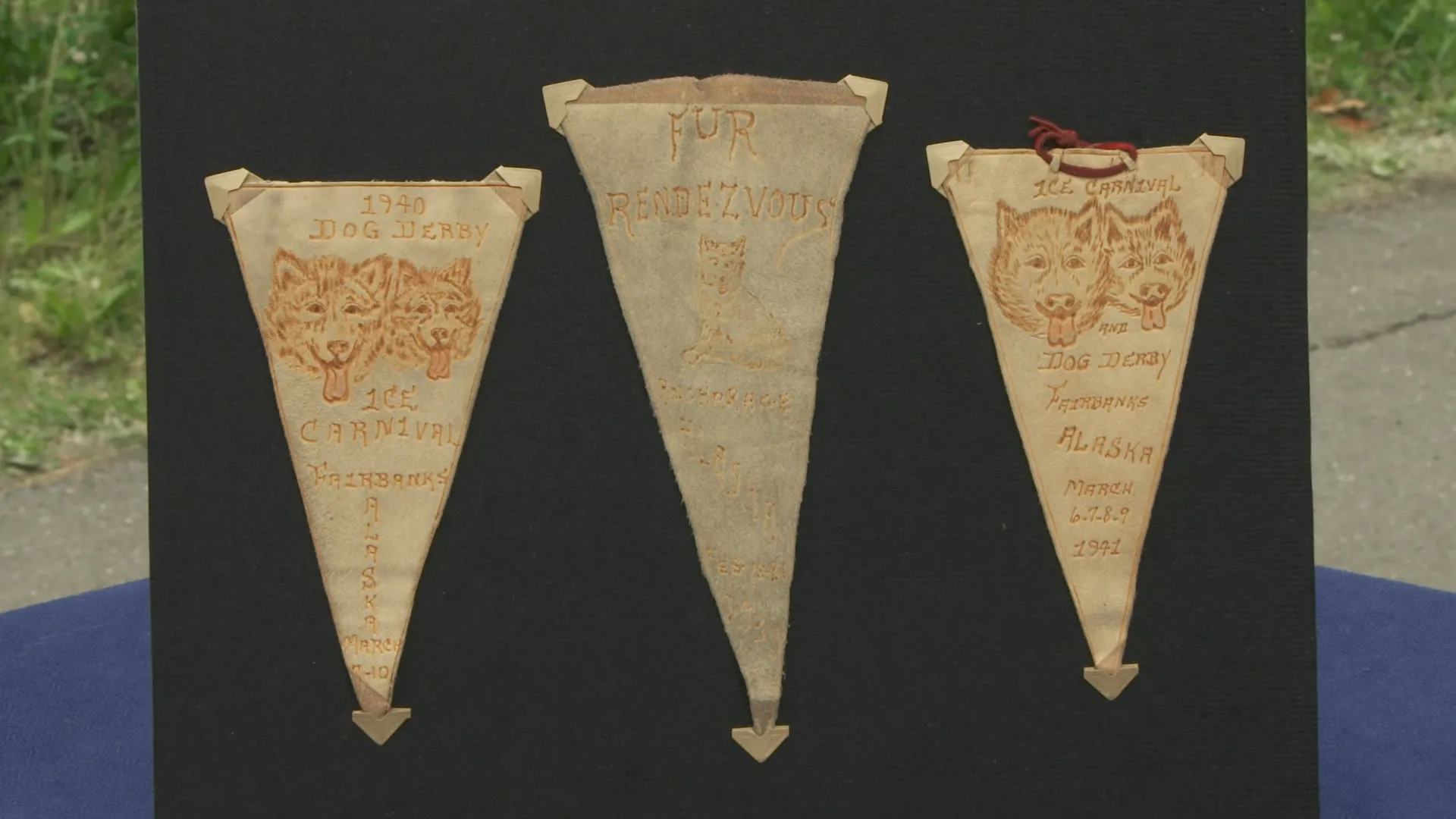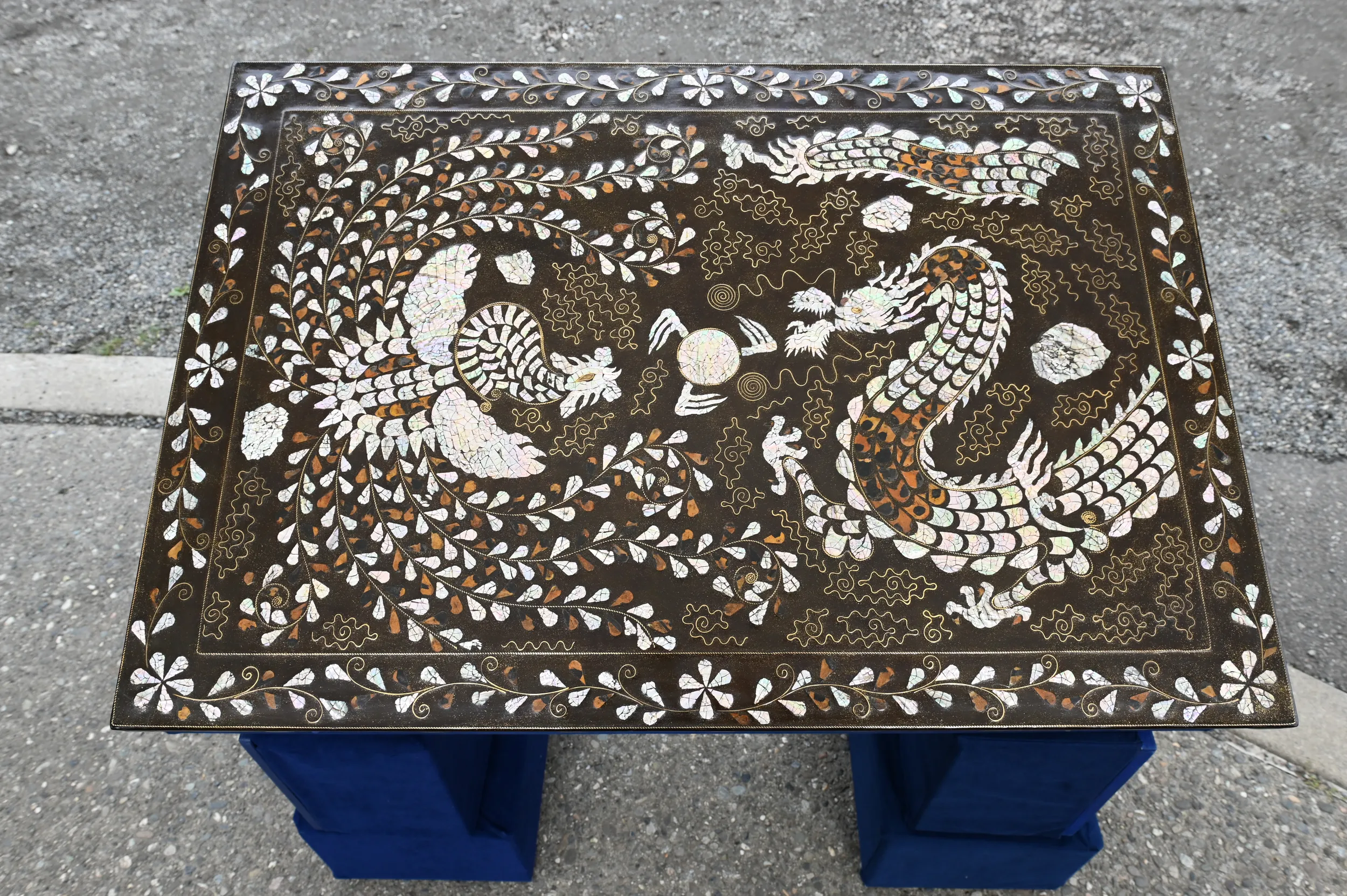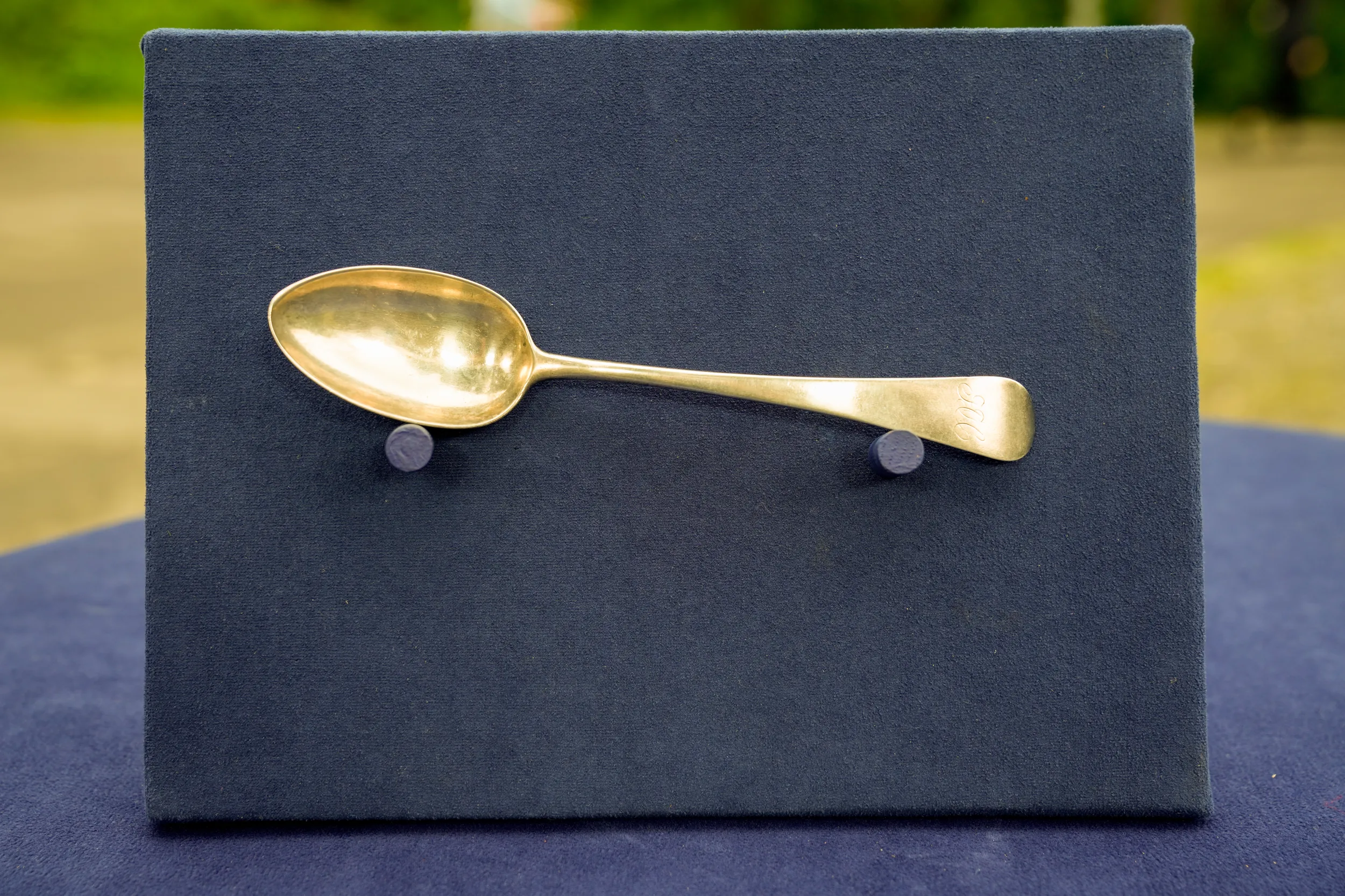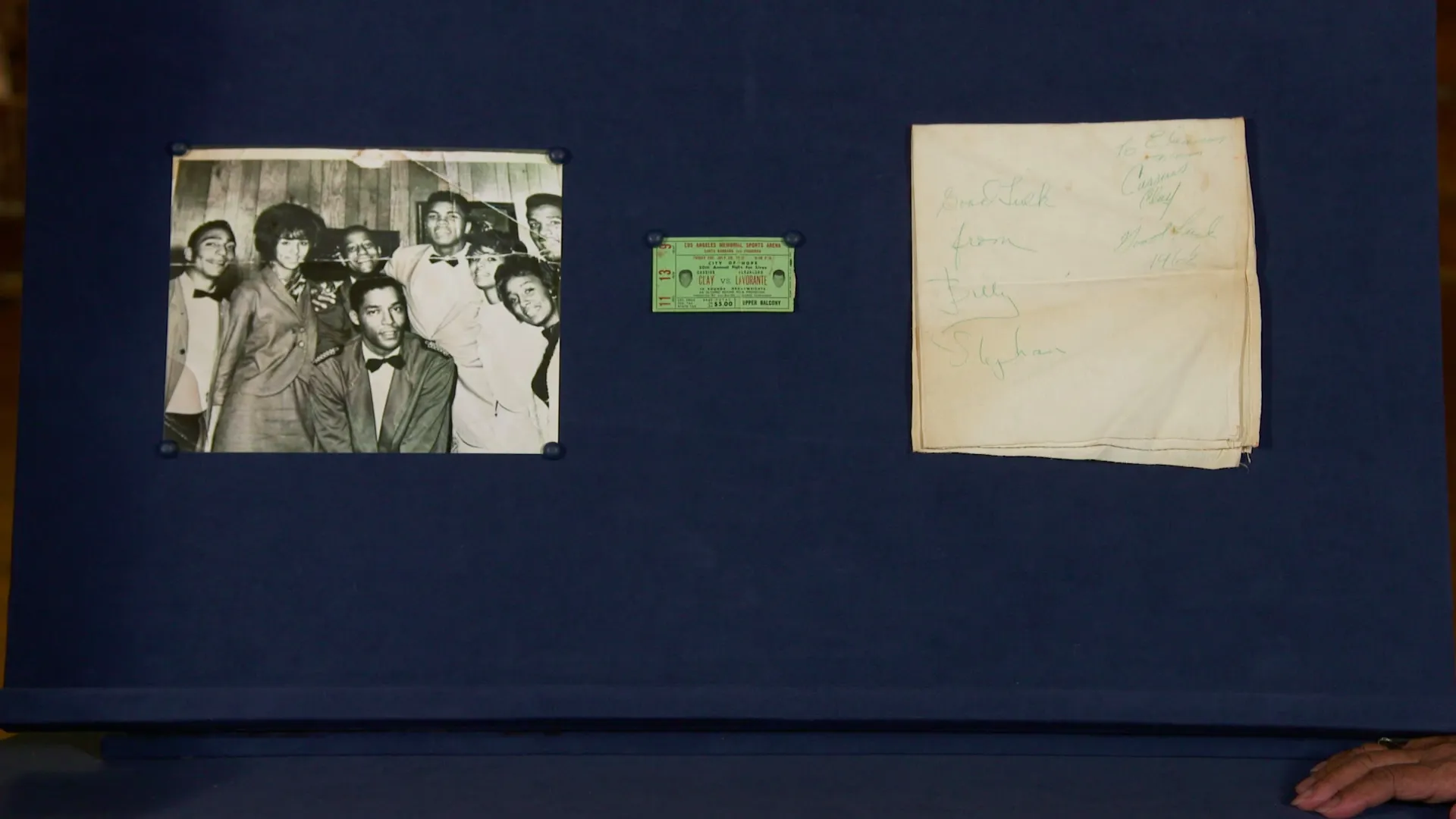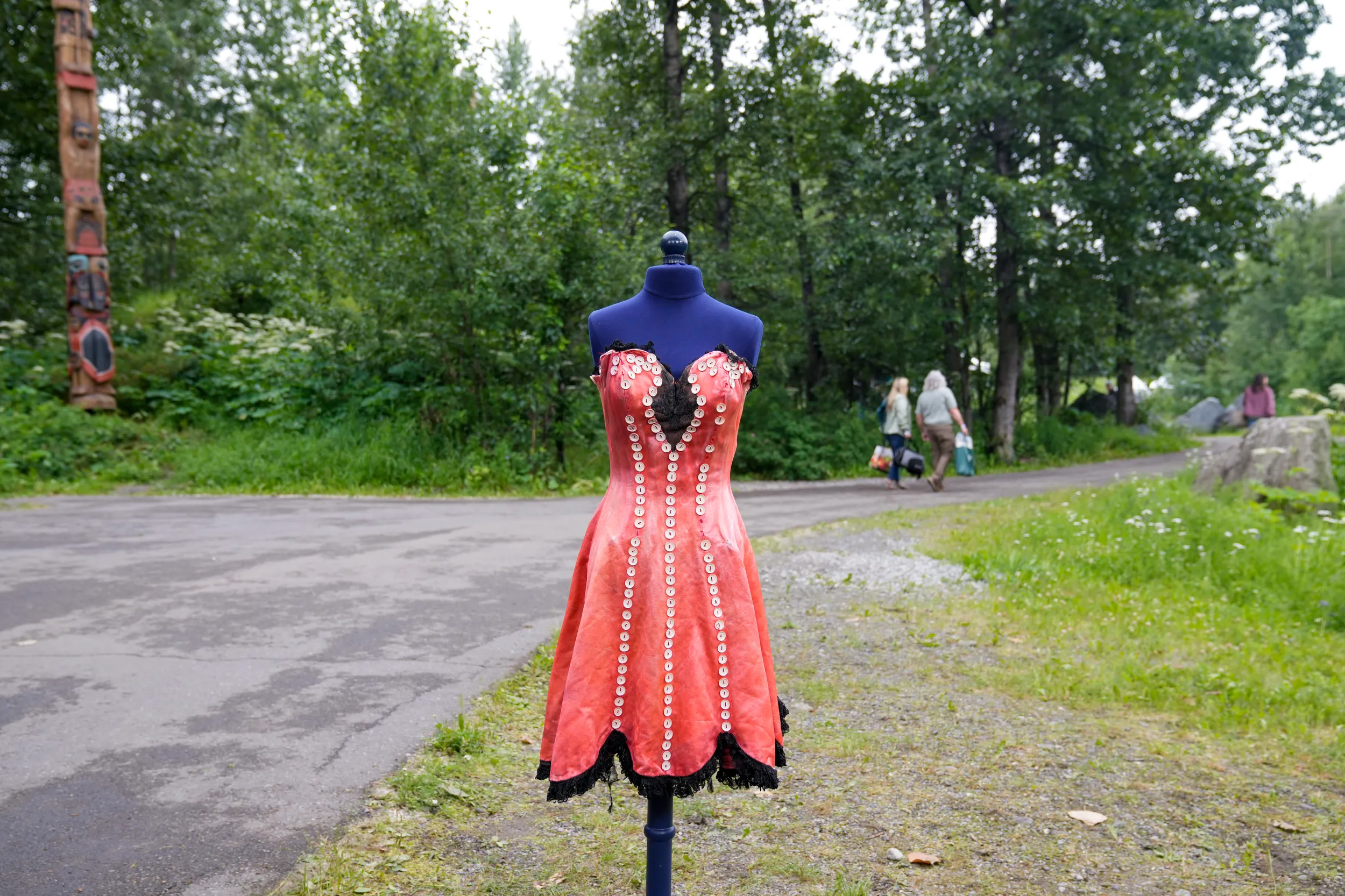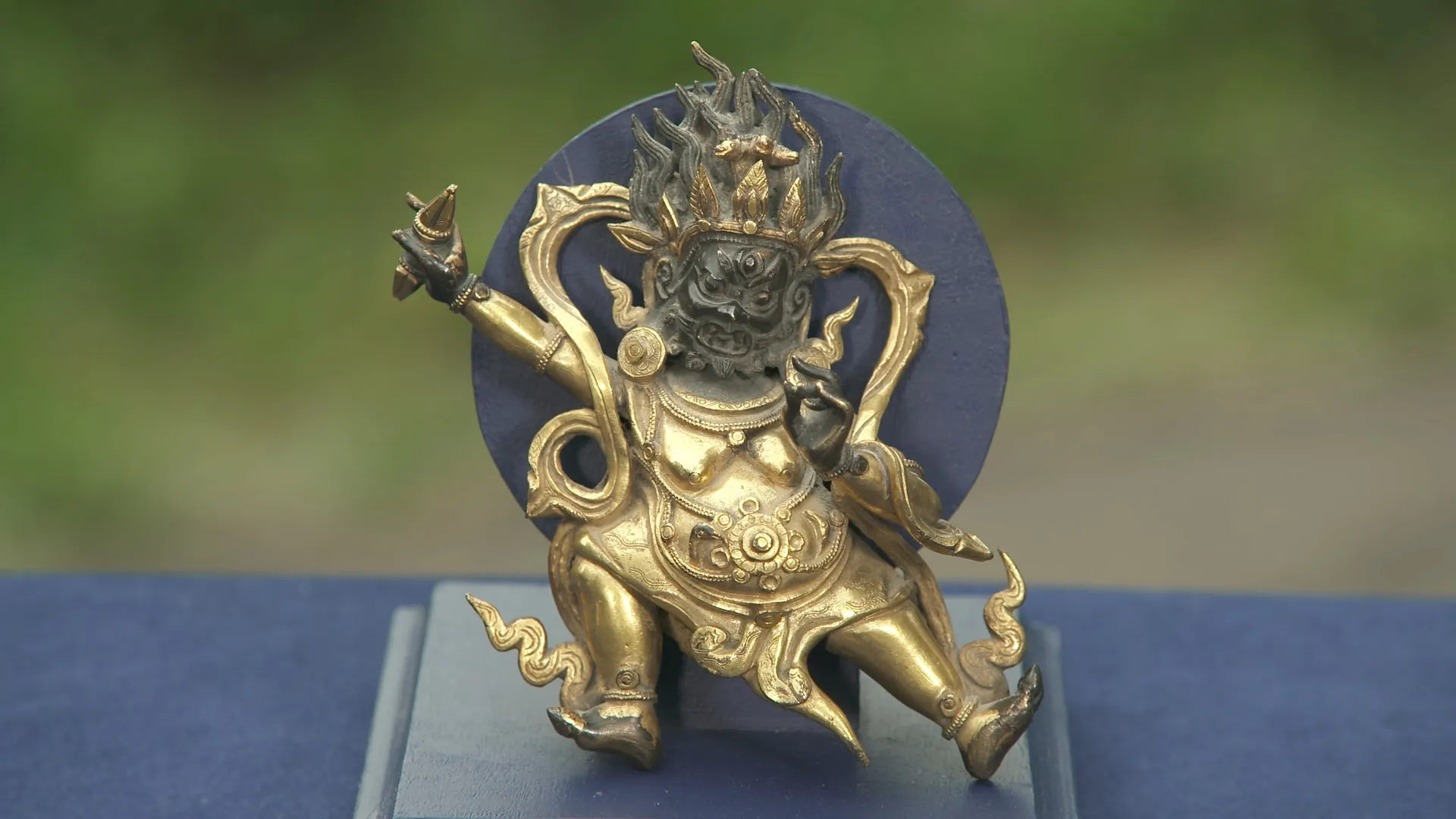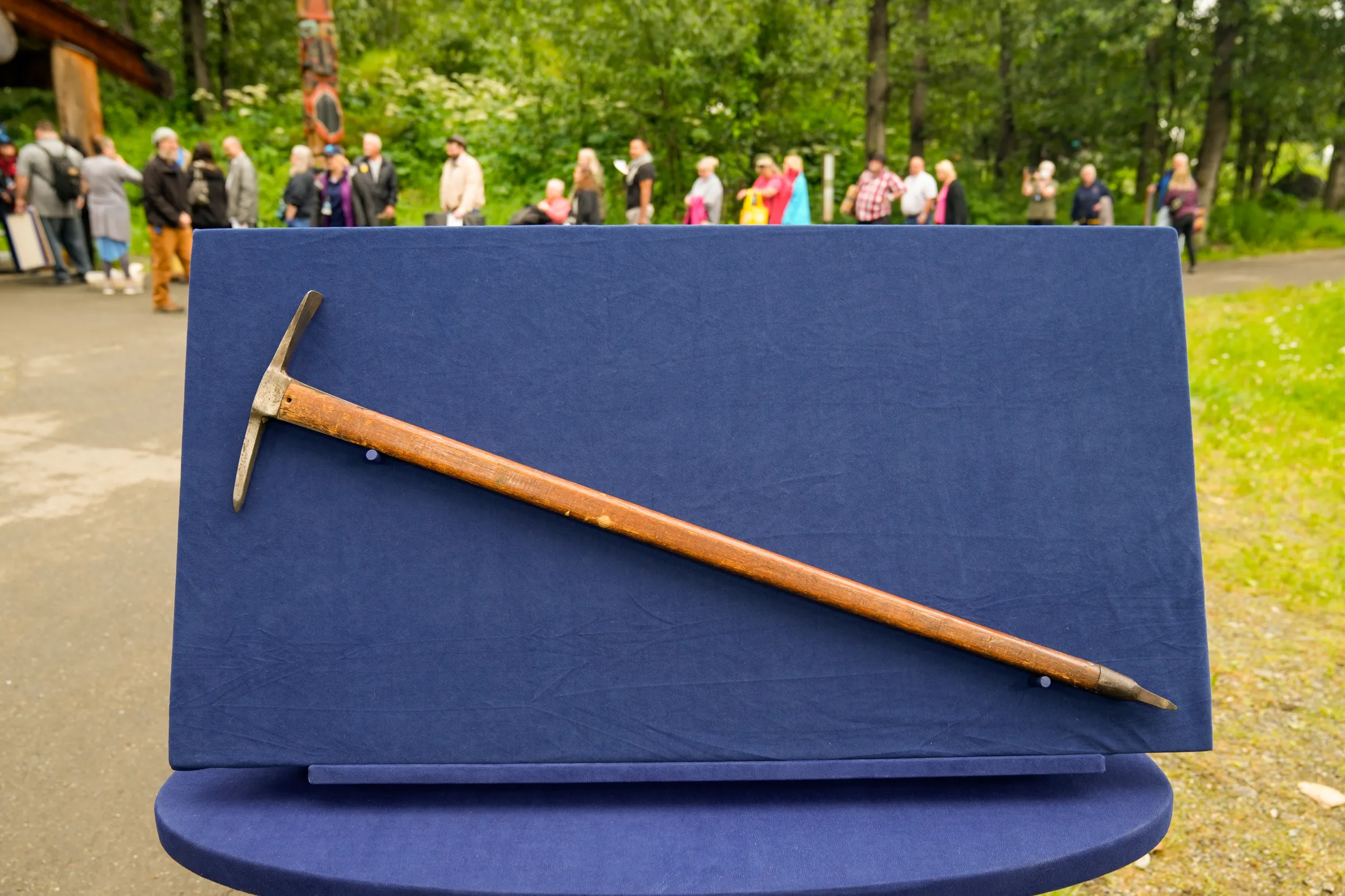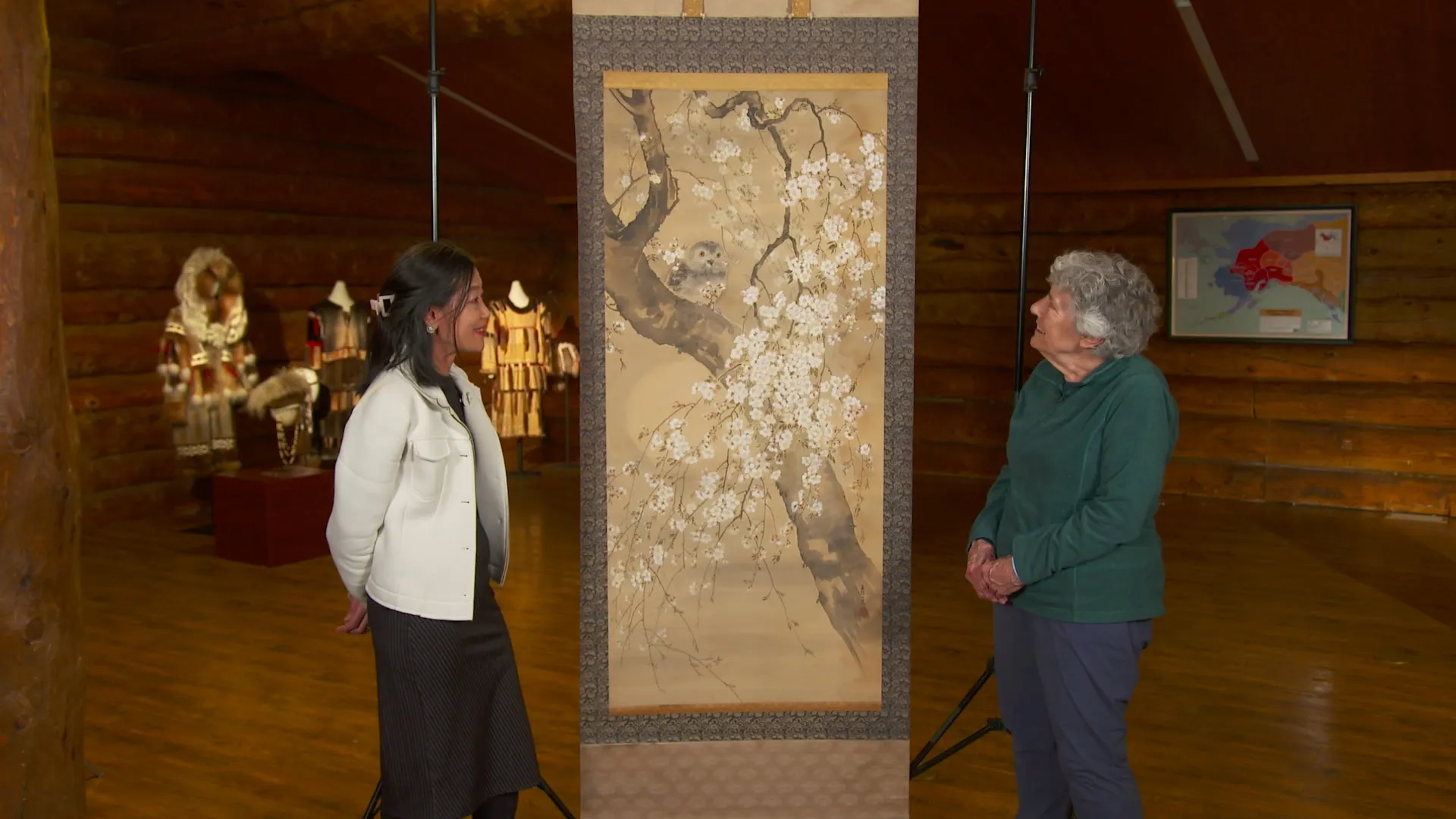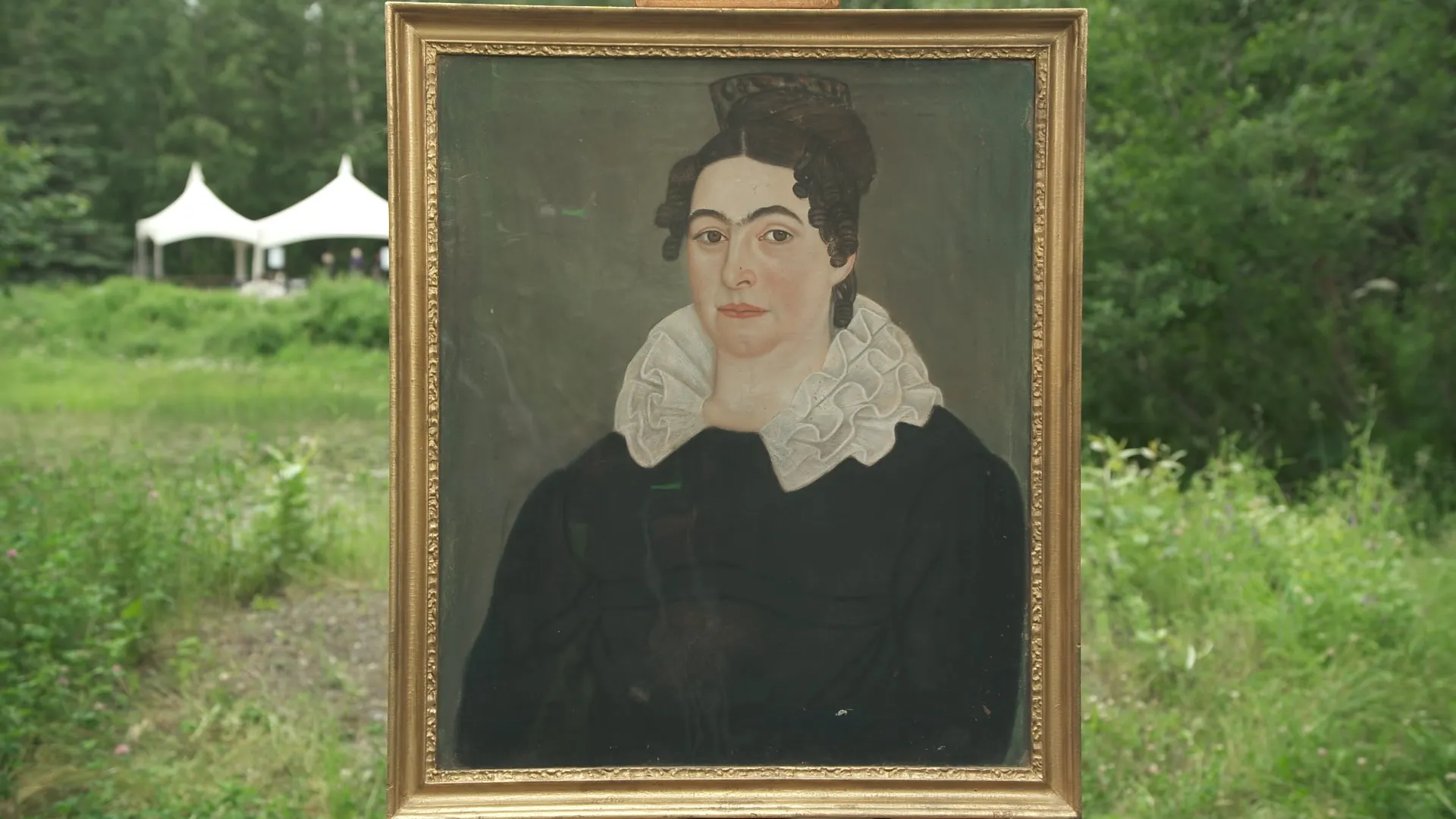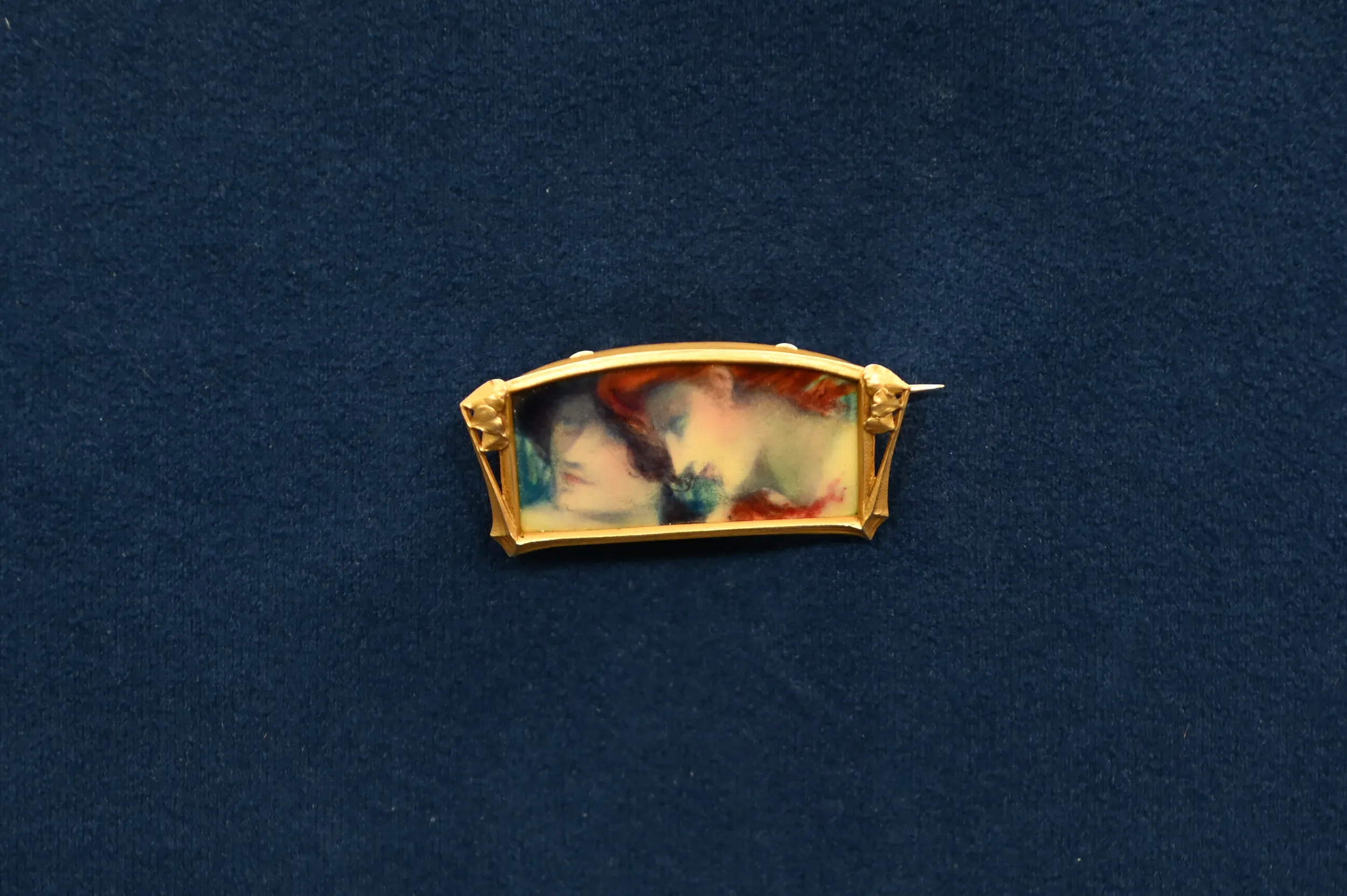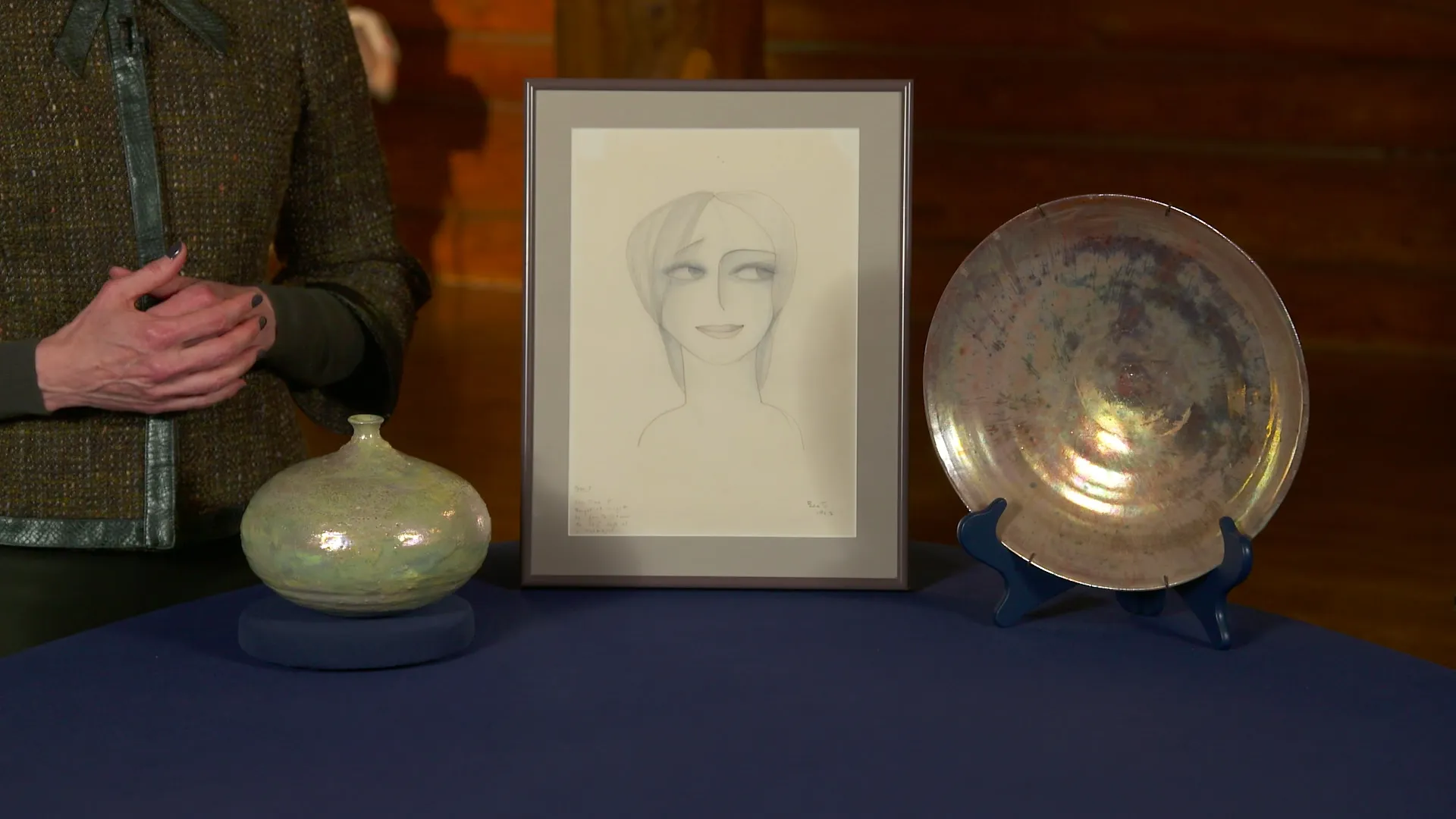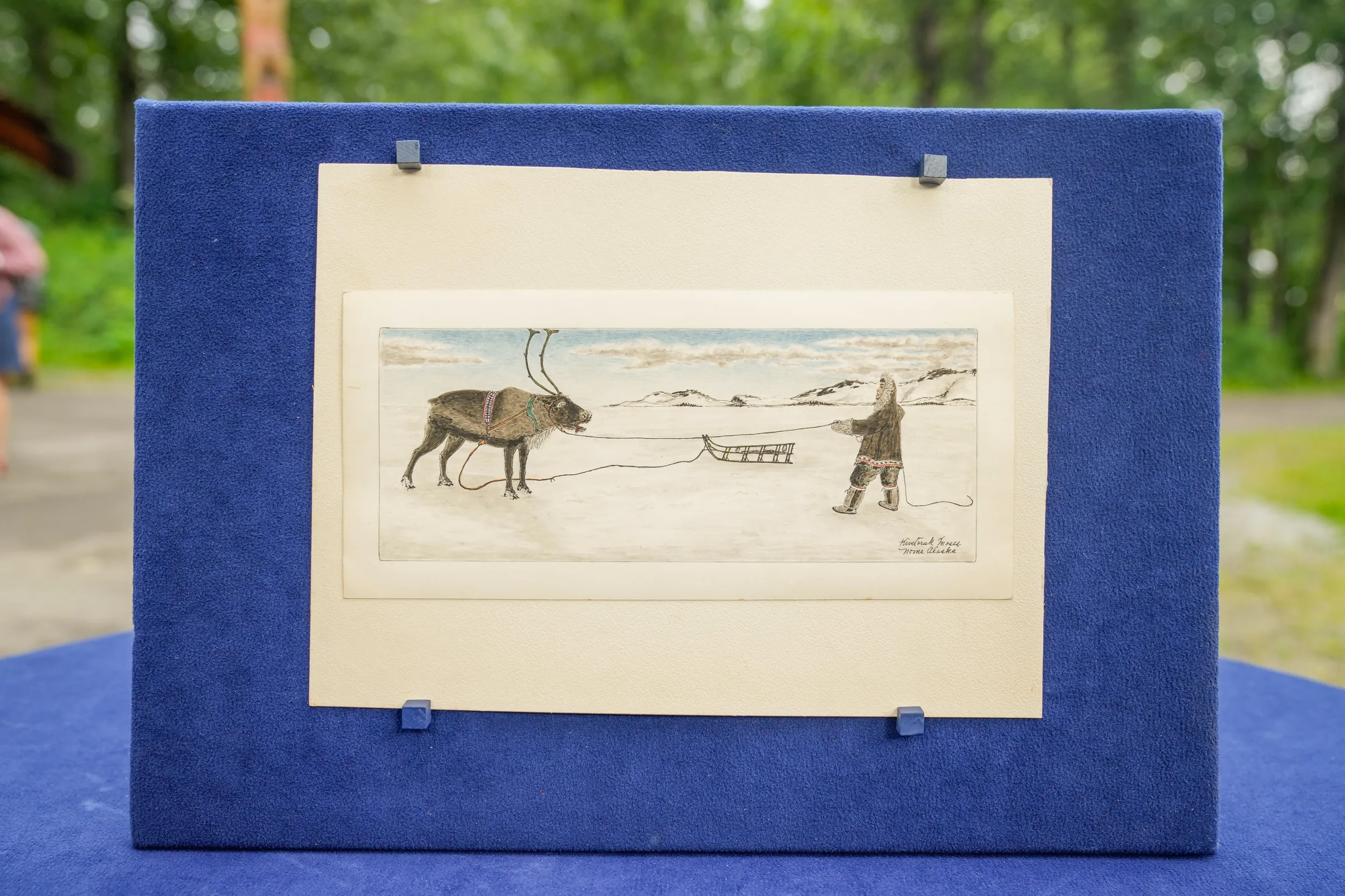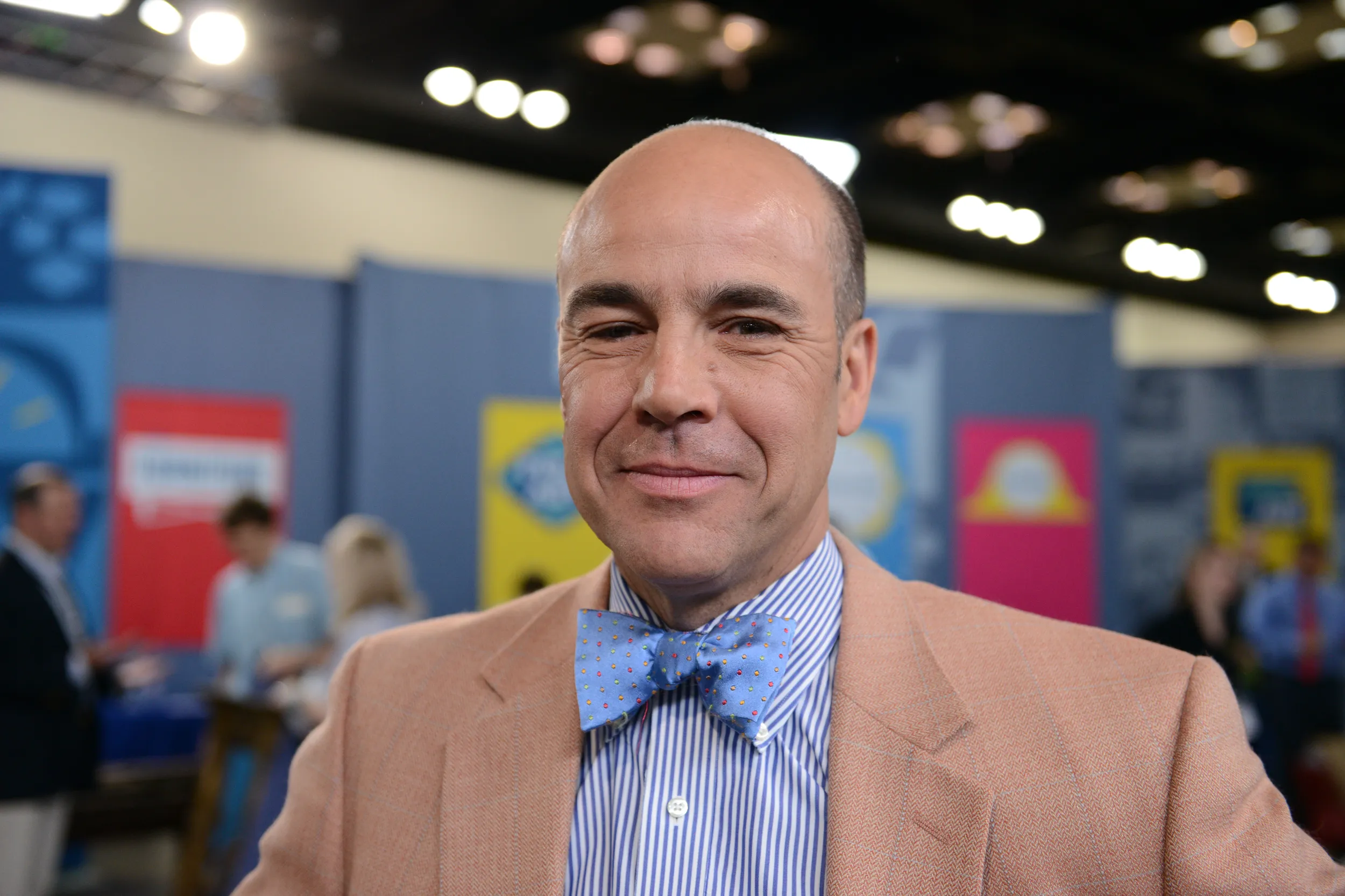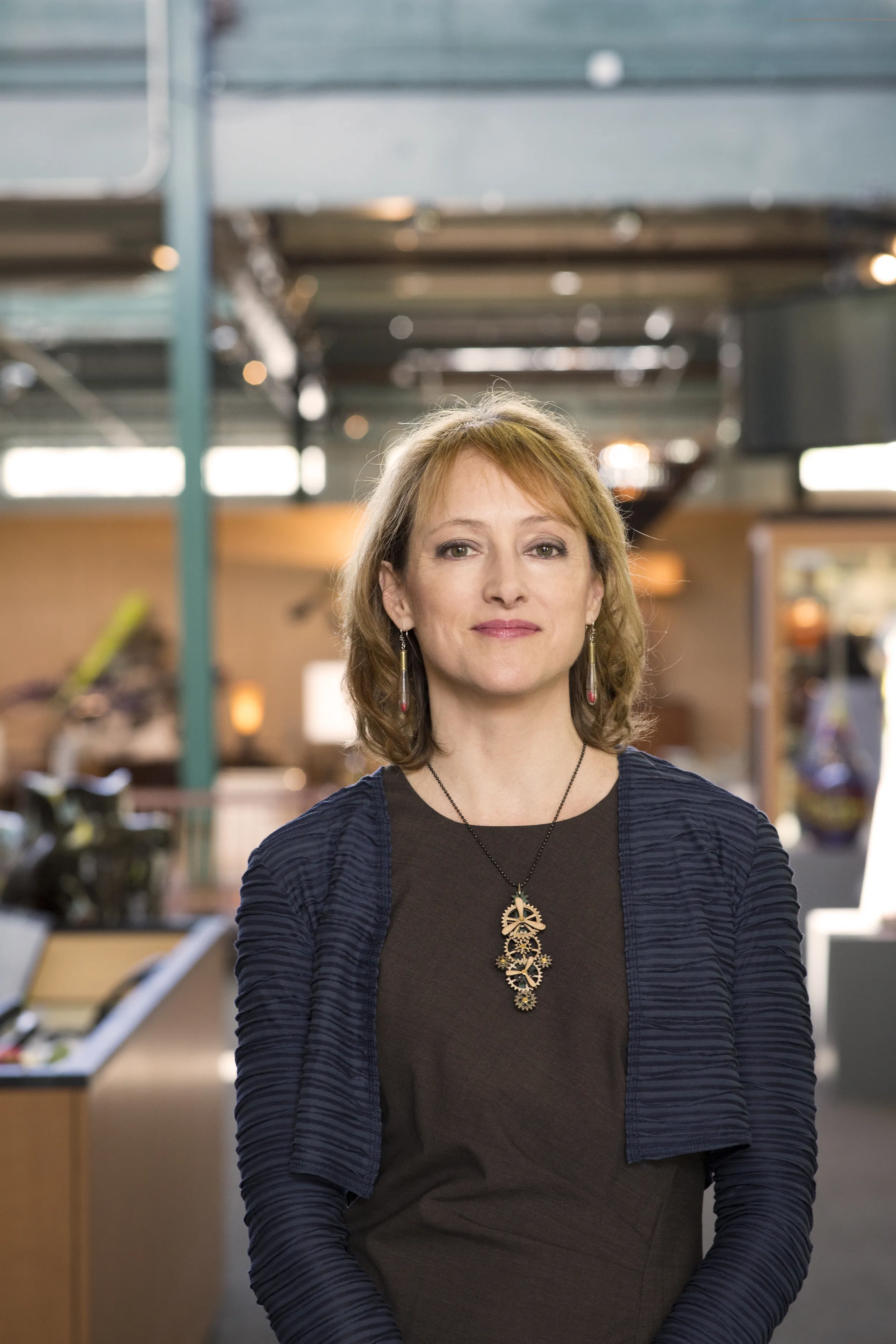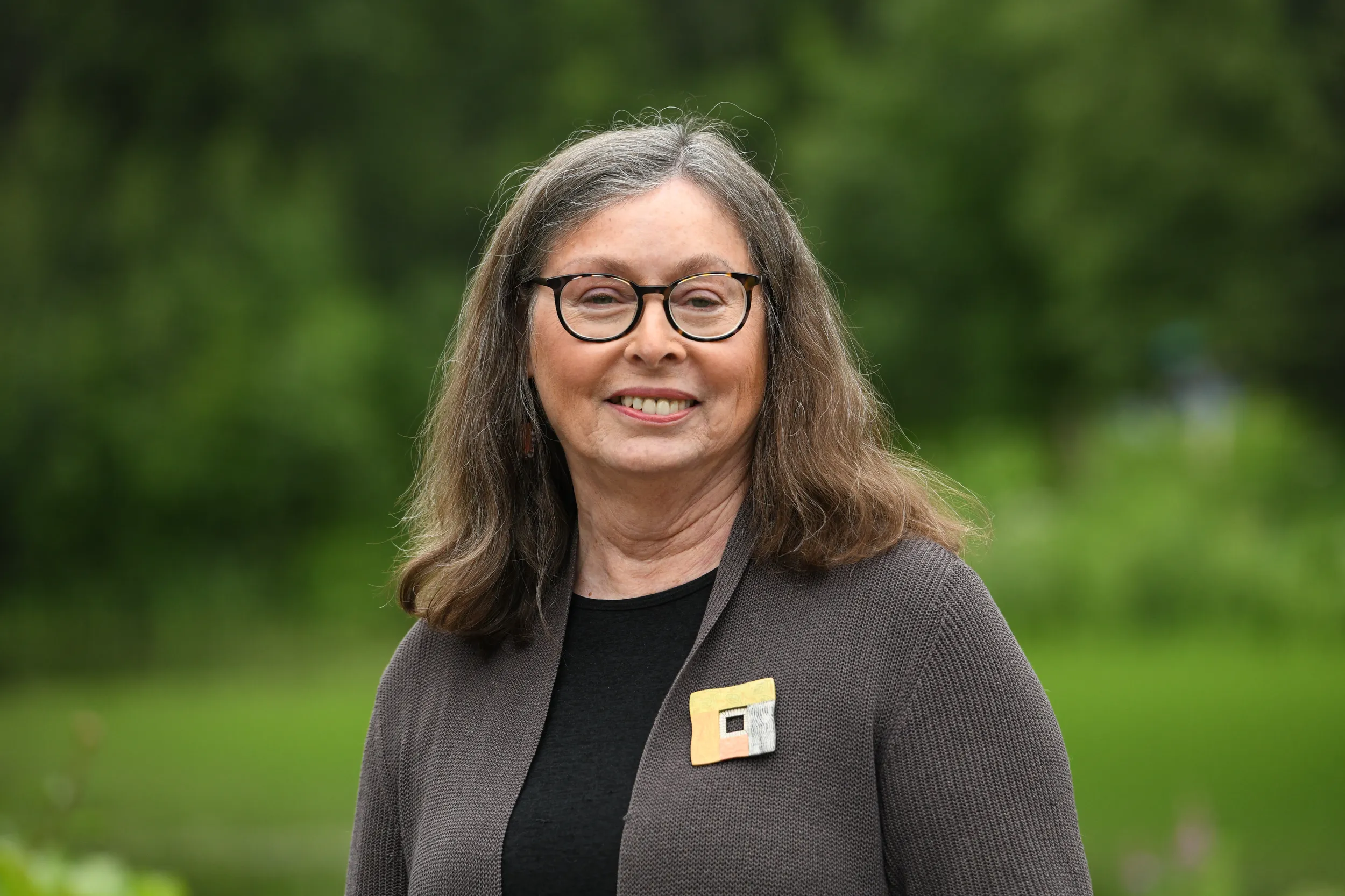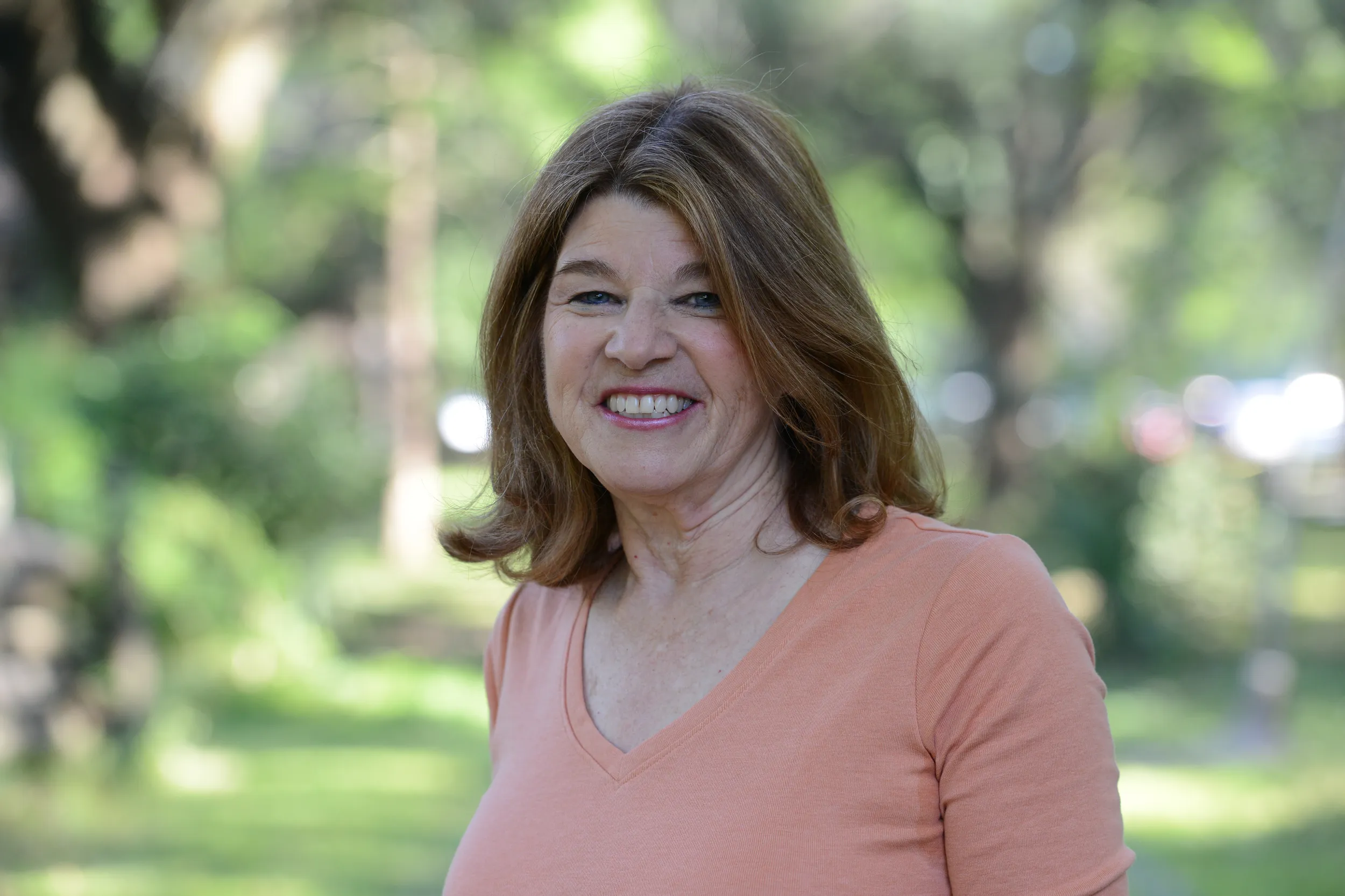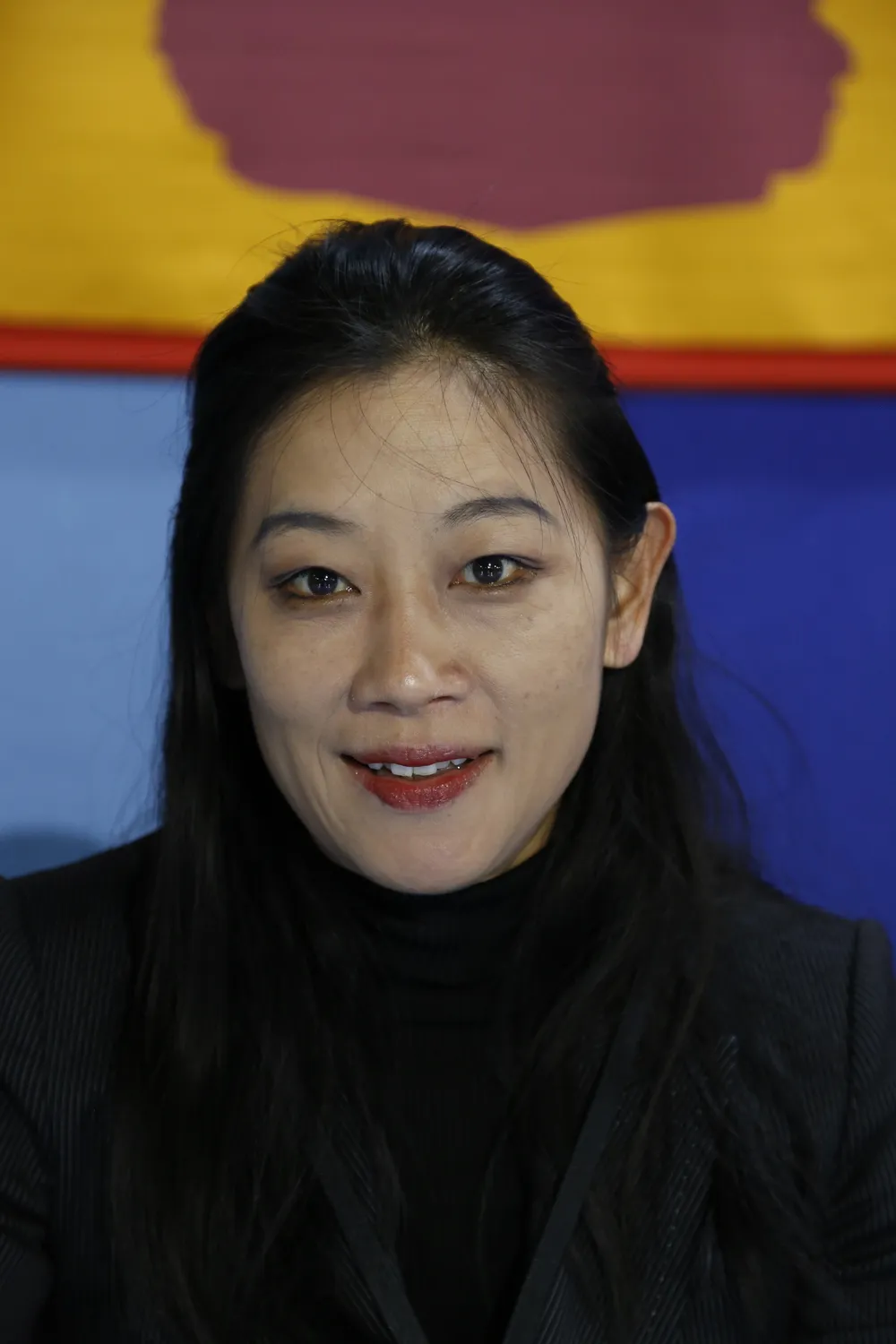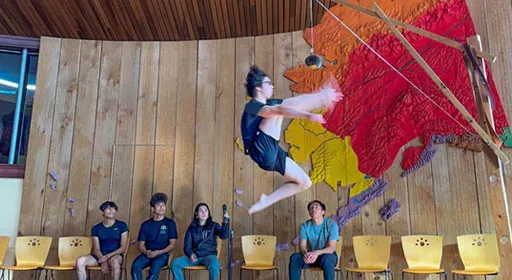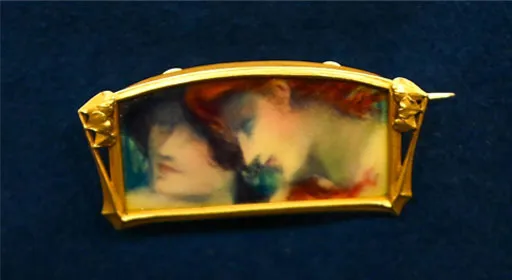HOST: ROADSHOW is thrilled to be anchored down in Anchorage, at the Alaska Native Heritage Center.
GUEST: On his butt, there's a fox. (laughing) So, you know, you have to buy something that has a fox butt.
GUEST: You're kidding!
GUEST: Now I gotta lock it up.
(guest and appraiser laughing)
HOST: The Alaska Native Heritage Center is located in Anchorage, the traditional homelands of the Dena'ina Athabascan people. Its goal is to educate, preserve, and celebrate the Indigenous art, languages, traditions, and cultures from all around Alaska. Six authentic Native dwellings surround Lake Tiulana. One, a Dena'ina Athabascan cabin, is based on the recollections of elders from Eklutna, Alaska. The very sturdy structure was used in winter and designed to withstand the weight of heavy snow. Cabins like these were made warm and cozy, with a fire in the center of the front room and by heating volcanic rocks that would be placed in the back room.
HOST: The hunt for treasures is heating up at our event today. Let's see what our cameras caught in Anchorage.
(talking in background)
APPRAISER: From what I'm told being in Alaska, come February, the Fur Rendezvous is the iconic staple event.
GUEST: Mm-hmm.
APPRAISER: Have you been every year to the Fur Rendezvous?
GUEST: As kids, we went every year. It was a big deal. My stepfather gave my mother the pins, or pendants, in this case. She passed them on to me. I collect the Rendezvous buttons and pins throughout the years.
APPRAISER: The Fur Rondy, as known today, started in about 1936, but in '36, it was just a three-day sporting competition. Mm-hmm. Skiing, hockey, anything you could-- it was a athletics competition. So the pennant we have in the middle, that is our star of the day. That is from the 1939 Fur Rendezvous in Anchorage. That would happen every year in February. 1939 was the first year they introduced the pins and pennants.
GUEST: Mm-hmm.
APPRAISER: Fun souvenir take-home items. Now, when I look over the events, I mean, it is incredible. Outhouse races...
GUEST: (chuckles): Yes, uh-huh.
APPRAISER: My favorite one: a Mr. Fur Face competition.
GUEST: Oh, yeah.
APPRAISER: I mean, I'm not just going to volunteer myself, but I'm pretty sure I already win the Furriest Appraiser Award...
GUEST: (chuckles)
APPRAISER: ...so I would have no problem growing out this beard...
GUEST: Mm-hmm.
APPRAISER: ...to compete in Mr. Fur Face competition.
GUEST: Yes, yeah.
APPRAISER: But all jokes aside...
GUEST: Mm-hmm.
APPRAISER: ...the Fur Rendezvous is very important...
GUEST: Mm-hmm.
APPRAISER: ...because it was a symbolic marking of the end of winter for Alaska.
GUEST: Mm-hmm.
You have trappers and miners coming down, taking the fruits of their labor from working through winter.
GUEST: Mm-hmm.
And it's this big, rip-roaring festivity of a lot of fun games.
GUEST: Mm-hmm.
APPRAISER: I mean, there was even a trappers' and miners' ball. The two pennants on the outside are from the Dog Derby and Ice Carnival, which took place in Fairbanks, this one from 1940, and the other one on the side from 1941.
GUEST: Mm-hmm.
APPRAISER: These pennants have actually come up for sale before.
GUEST: Hm, oh.
APPRAISER: And they only achieve in the maybe $200 to $300 for the pair.
GUEST: Oh, wow.
APPRAISER: This pennant in particular...
GUEST: Mm-hmm.
APPRAISER: ...is extremely rare. From what we've done in research, and talking to our local experts here, when I showed him your pennant, his eyes lit up. It was incredible. He had never seen a 1939 pennant like this.
GUEST: Hm. Sweet.
APPRAISER: For the 1939 Fur Rendezvous pennant, I think conservatively at auction...
GUEST: Mm-hmm.
APPRAISER: ...you could see that achieve between $8,000 and $12,000 today.
GUEST: Ooh, thank you-- oh, sweet. (laughs) Yeah, very exciting.
GUEST: I got it from a lady I was vacuuming for, and it was kind of in the way, and she picked it up and went, "Do you want this?" And I'm, like, "Well, what is it?" She's, like, "It's a telescope." And she had it, like, mummified in packing tape. And I tried to open, she's, like, "No, no, no, open it at home." I'm, like, "Okay, I'll open it at home." And it's signed by the maker, Ramsden of London. And it's got a little Navy serial number on it, too. Ones that I found online that are identical were made in the late 1700s, but... I don't know.
GUEST: I bought these little records and read-along books that my grandma got for me when I was really little, like, Cinderella, Peter Pan, uh, I don't know, Winnie the Pooh. My grandma was into getting us things and then not letting us actually play with them, so... (laughing): They're in good condition.
GUEST: The Atwoods were a very big family in Anchorage. Especially Bob Atwood was one of the big movers and shakers behind Alaska statehood. When the last Atwood died, the Atwood Foundation was selling the house, and they had an invitation-only estate sale, and my mom got an invitation, so she dragged me along.
APPRAISER: I'm curious, when you went in the Atwood house, were there other things like this?
GUEST: There was a whole room that was full of Asian art. I paid $300. It was not long after I'd graduated college. (chuckling): So it was a lot of money for me, and it was my first really big purchase. I grew up in the Japanese immersion program locally and studied Japanese and Chinese through college. And I'm actually now a, a local Japanese teacher.
APPRAISER: Oh.
GUEST: Um, so I've, I've always loved the art, and, and the culture, and the language. When I asked the people who were running the estate sale, they said they thought it was Korean, and I'm, like, "Well, that's the area I don't know in East Asia." (laughs)
APPRAISER: It is Korean.
GUEST: Oh, cool.
APPRAISER: The decoration, it's so striking. A dragon, phoenix, and in the center, the pearl of wisdom, sometimes called the flaming pearl. The surface is a dark caramel color, but if you look at it really carefully, you see it's infused with little flecks of gold. You see this rope-twist brass outlined border surrounding all the different elements. And then broken shell that has been polished. This kind of speckled caramel, dark brown. This sea turtle shell. For something of this age and this type, there are no real restrictions on this sea turtle shell, but it's something that one should explore prior to selling. Those laws and regulations change.
GUEST: Mm-hmm.
APPRAISER: One of the great accomplishments in the arts in Japan is the use of lacquer. The dark-color ground of this is lacquer. From 1910 to 1945, Korea is annexed by Japan. And I'm wondering if this very high-quality workmanship that we see on this table, which is from that period, 1910 to 1945, was a reflection of interest by the Japanese in their own tradition of working with lacquer. And perhaps it would have been intended partially for not just a Korean audience, but also a Japanese audience. Hard to say.
GUEST: Wow. (chuckles)
APPRAISER: The symbolism is indicating marital harmony. Not only is this talking about marital harmony, it's looking back into the very foundations of Korean society. I think, for insurance purposes, I'd value this at $3,000.
GUEST: Wow. (laughs) Oh, my goodness. (sighs) I might have to stop putting my feet on it. But... (laughs) Thank you.
GUEST: I have brought a serving spoon that I believe was made by Paul Revere. My husband bought it seven, eight years ago, uh, in Baltimore.
APPRAISER: Can you tell me how much your husband paid for the spoon?
GUEST: I think he said $600.
APPRAISER: The spoon is hand-wrought with a tapered handle. It's constructed from coin silver. It is a large spoon, a tablespoon.
GUEST: Yeah.
APPRAISER: And what you mentioned about Revere, if we turn it over, you'll see the mark reading "Revere."
GUEST: Right.
APPRAISER: And that mark is indeed for Paul Revere, Jr., who was born in 1734 in Boston, Massachusetts. He apprenticed as a smith under his father. He was a silversmith leading up to the Revolutionary War. Yeah. And is most iconically known for his great midnight ride in April of 1775 when he was warning the colonial militia of the impending British forces arriving at Lexington and Concord. He resumed his work in silver after the war, which I believe stylistically matches when this piece would have been made.
GUEST: Okay.
APPRAISER: Likely circa 1780 to 1790, somewhere in there. He continued acting as a smith until his death in 1818. And if we flip it back around here, you'll make note of a monogram. It's quite common that that monogram can likely be associated with a direct owner, which could potentially increase the value of the spoon. Mr. Revere, after his death, his firm would continue on for some time.
GUEST: Right.
APPRAISER: However, this one is very apparently done by his hand during his lifetime...
GUEST: Mmm.
APPRAISER: ...which is what makes it special. The construction is what we would expect to see from one of his spoons. They are quite scarce. They do exist, but I would say numbering, in total known examples, low hundreds.
GUEST: Great.
APPRAISER: The size is exceptional. Typically, we'll see smaller teaspoons.
GUEST: Mm-hmm.
APPRAISER: Perhaps seven, seven-and-a-half inches. This one has got to be close to nine inches, and you can really see that large bowl there on the end, indicative of a proper tablespoon, which further adds to the value. This spoon would likely garner $8,000 to $10,000...
GUEST: Whoa.
APPRAISER: ...should it cross the auction block.
GUEST: That's amazing. A spoon. (laughs)
APPRAISER: A spoon.
GUEST: Ah, well, this is terrific, thank you.
APPRAISER: If it were a teaspoon, you'd likely be closer to probably the $6,000 to $8,000 range.
GUEST: Oh, fantastic.
HOST: John Hoover's monumental bronze sculpture Raven the Creator greets guests at the entrance to the Alaska Native Heritage Center. This intelligent bird is identified as the original creator of the world in many Indigenous peoples' mythology. Made in 1988, several symbols adorn the animal: stars, sun, and moon, and, in the belly of the bird, a human, to represent Mother Earth.
APPRAISER: Here we have this photo of a very young Muhammad Ali, known then as...
GUEST: Cassius Clay.
APPRAISER: ...Cassius Clay. We have a 1962 fight ticket here, and we have this interesting piece of cloth that's signed to Eleanor from Cassius Clay. So my question to you-- and I believe that you are also in this photo with Mr. Ali-- was this a chance meeting?
GUEST: I had been invited to go to the fight, and afterwards said, "Let's go out to dinner." And then we were at dinner, and I stole the napkin, people wrote on it...
(both laughing)
GUEST: And then they said, "Let's take a photograph." So we were standing out there, my friend Emily, who's between Cassius and his brother Rudy, and my friend Gail, the one with the big bubble hair on the other side. (chuckles) And when my girlfriend sent me that photograph, I said, "Golly, Emily, that was a long time ago." I said, "Is that Smokey Robinson in there?" (chuckling):
APPRAISER: That's right, on the left hand side here, yes. (chuckles):
GUEST: Yeah. And she said, "No, no, those are the busboys that jumped into the picture." (both laughing)
APPRAISER: So it was one big party.
GUEST: Yeah, it was.
APPRAISER: How did you meet him?
GUEST: I met him because Howard Bingham, a photographer from the local Black newspaper... Mm-hmm. ...was always taking us places. "You want to go see this, want to see that?" And so the-- he, Cassius, and Archie Moore had been boxing, training, at the 6th Street Gym in downtown L.A. So we watched him for a few days, a couple of hours. I was 18, so something didn't hold my attention a long time. (chuckles) And he said, "Do you want to go up to his room and meet him?" "Sure." So we went up to the room. He and Rudy were sharing a room together. And he was the sweetest-- I'm going to say boy, 'cause he was really unsophisticated.
APPRAISER: What do you remember about this photo when he said he wanted to take it?
GUEST: Howard was taking pictures all the time.
APPRAISER: Okay.
GUEST: Wherever Cassius was...
APPRAISER: All right.
GUEST: ...Howard was there, and he... At that time, we didn't know he was going to be his lifetime photographer.
APPRAISER: This was sort of the beginnings of all of that.
GUEST: Yes, yes.
APPRAISER: So how did you get him to sign the cl, the napkin? When you're almost famous, you want your autograph everywhere, right? (laughs)
(both laughing)
APPRAISER: That's right.
GUEST: And Cassius was always telling people who he was, what he'd done, and he was going to be famous. He was going to be number one.
APPRAISER: On this side, we have the Cassius Clay signature, Billy Stephan.
GUEST: Yes.
APPRAISER: And on the other side, there's a long inscription from Cassius Clay's brother...
GUEST: Yes.
APPRAISER: ...uh, Rudolph. And also there's a signature from heavyweight champion Archie Moore.
GUEST: Yes.
APPRAISER: This is a very, I think, overlooked period in his history.
GUEST: It is.
APPRAISER: When he was Cassius Clay. From '60 to '64, he had won the gold medal in Rome, and then he started his professional career.
GUEST: Right.
APPRAISER: And he was working his way up.
GUEST: Worked his, yeah, but he knew he was going there.
APPRAISER: Absolutely. But he was developing his style...
GUEST: Mm-hmm.
APPRAISER: ...and he was knocking out, consistently, his...
GUEST: Yes.
APPRAISER: In fact, he knocked out Alejandro Lavorante.
GUEST: He did, he did.
APPRAISER: I, five rounds, I believe.
GUEST: Yes.
APPRAISER: And by the time you hit the end of 1963, he was 19-0. And everything changed in 1964.
GUEST: It did.
APPRAISER: He, he managed to get a shot at the heavyweight title. He upsets Sonny Liston.
GUEST: Yes.
APPRAISER: And then he becomes Muhammad Ali, changes and converts to Islam.
GUEST: I know, and just, people flipped out. They didn't know what being a Muslim meant. He didn't either, much. But he knew he didn't want to be this colored boy from Kentucky. That was not his story.
APPRAISER: He had to take on a new persona.
GUEST: He did.
APPRAISER: So he went on to transcend sport, between him becoming a conscientious objector in the Vietnam War, subsequently losing his boxing license...
GUEST: Yes.
APPRAISER: ...from '67 to '70. And then the great comeback, reestablishing himself as heavyweight champion with the trilogy against Joe Frazier, Rumble in the Jungle with George Foreman, and finally, becoming a great humanitarian.
GUEST: Yes. I think his career was educational for America and the world. But he had such a persona and he never backed down from who he was. And he made people listen. It's a legacy that says you don't have to stay where you started.
APPRAISER: So when we value autographs, one of the first things we look at is the historical importance. And, of course, this is as good as it gets. But another major factor is rarity. And Muhammad Ali signed as Ali from '64 until his passing in 2016. Ca, his Cassius Clay signatures are predominantly from 1960 to 1964, a much shorter period of time...
GUEST: Yes. ...much rarer, and therefore, much more valuable.
APPRAISER: To me, what's very important here is the photo and the ticket, because they support the napkin, it supports the provenance and the story, but they in and of themselves do not have significant value. The value is actually really in the napkin, the signature, and the fact that we can pinpoint exactly when he signed it. Because another big issue in this day, it, fakes and forgeries. (laughing): So, we have no issue here, in regards...
GUEST: I'm in it.
APPRAISER: You have perfect provenance. We have you. (laughs) I would put an auction estimate for $3,000 to $5,000.
GUEST: You know, that's amazing. I never thought of a value. I just wanted people to know that I was there with him. (both laughing) And I'm kind of a devotee. (laughing): I watch you every week on ANTIQUES ROADSHOW, so, thank you.
APPRAISER: And now you're a part of it.
GUEST: Yes! (laughs)
GUEST: These are pieces of the Alaskan pipeline that were cut out and made into art by the pipeline welders' union that were making these pieces for fun out of scrap pieces of the pipeline. My father and my grandfather ended up with a piece each.
APPRAISER: And so they both worked on the pipeline?
GUEST: They both worked on the pipeline.
APPRAISER: Well, and they're curved, like the pipeline.
GUEST: Right.
APPRAISER: They're curved. The pipeline was 1975 to 1977, when it was being built. So these date from that time period. And, actually, quite a few of them have come up, so they must have made a lot of them. They tend to sell in the $400 to $600 range.
GUEST: Ooh!
APPRAISER: Each.
GUEST: Each-- nice! (laughing):
APPRAISER: Yeah, each, yeah. This is probably more like the $600 one and that's probably more like the $400 one.
GUEST: Okay. I'll pass it on to my boys and see. (chuckles) (laughs) Maybe they'll be able to enjoy these.
APPRAISER: Definitely a thing to hold on to, uh, if you can hold them that long. (laughing):
GUEST: If you can hold on to them this long, they are heavy.
(both laughing)
GUEST: My mom owned it most recently, and I inherited it from her when she died in 2019. It belonged-- and I don't know if she's the original owner-- but it belonged to my great-great-aunt, who lived in Sugar Notch, Pennsylvania. My mom and her siblings would go to their great-aunt's house, and the table has some interesting mysteries. They would come and push a secret button on the table that pops open a drawer, and there would be dollar bills hidden in the drawer. And so they were excited to get a, a dollar. I don't know who made it. One story is that it was made by an individual, perhaps a family member that was in jail for bootlegging, and they made it while they were in jail.
APPRAISER: Let's take a look...
GUEST: Sure.
APPRAISER: ...and see if we can find any dollar bills. I'm going to do that by pushing on a little button that's hidden in a tree...
(button pops)
APPRAISER: ...and pop the drawer out. And as we look in here, this element here in the front is called a till, and the, the till is typical of blanket chests and those in the Germanic tradition, as well, the Pennsylvania Dutch. And it is hinged like that. Now, the other cool and unexpected feature is this secret bottom that can be pulled back to reveal two more hiding places. Another v, very fun feature is this spring, which was repurposed from a piece of upholstered furniture.
GUEST: Mm-hmm.
APPRAISER: And there's another one on the inside.
GUEST: Yeah.
APPRAISER: But clearly not made in a formal factory. This is something made at home. The parquetry top, you have a variety of woods: walnut, ash, oak, and maple here. Root furniture or twig furniture shows up in various disciplines. It's in the Midwest, it's in the Adirondacks, it's, comes from China, as well. This one, based on the secondary woods in the drawer and its homespun style, it does appear to be from that area of Pennsylvania. Sugar Notch is near Wilkes-Barre-Scranton, so it's not heavily into the Germanic culture of the 18th century, known as the Pennsylvania Dutch. It could be made by somebody who had Germanic influences, because the Germans also had Black Forest furniture.
GUEST: Mm-hmm.
APPRAISER: I would think it's probably around 1900. I'm not sure that helps to corroborate that story about being made in jail, 'cause I think that's probably just...
GUEST: Yeah.
APPRAISER: ...family lore, and apocryphal.
GUEST: I think it is.
APPRAISER: It's a good story.
GUEST: I think it is-- yes, yeah.
APPRAISER: The other thing that I think is just incredibly coincidental are the images that are, surround the side of the table, because it went from Pennsylvania to Alaska.
GUEST: Yeah.
APPRAISER: And as we look at the images, we're going to see what could be a, a caribou, or a reindeer, or just a great big stag. Let's have a look at this side. Some birds. There may be a figure over here on the side.
GUEST: Mm-hmm.
APPRAISER: But my favorite here is the one on the back, which shows a seated bear. She has brass tacks inset for eyes and a cub over here on the side. And then, finally, there are more birds. Over here we have something like a stork...
GUEST: Mm-hmm.
APPRAISER: ...or a heron...
GUEST: Mm-hmm.
APPRAISER: ...with a open flower in its beak. It's so good and so well-proportioned. Oftentimes, people who aren't trained as cabinet makers, they get some elements right, but not all of it, but it's really well-balanced. I would say, without hesitation, if this was gonna go to auction, I would put $10,000 to $20,000 on it.
GUEST: Oh, my God. Wow, I did not expect that at all. Wow.
GUEST: I grew up in Los Angeles, and in 1970-- I was 19 at the time-- MGM sold off all its costumes and properties. First, there was an auction of the valuable things. Most people have heard that the, Dorothy's ruby slippers from The Wizard of Oz sold for the highest price. But after they sold those high-profile things, they still had hundreds of thousands of items, which they sold in their warehouses. And, uh, near the end of the summer, it was near the end of the sale that I heard about it. Mostly, things were in poor condition. I was looking for things that would fit me, and I got three items for a total of $25. And when I got home, I found an tag in here that said "Angela Lansbury." So I started looking at her movies, and this was in a movie called Till the Clouds Roll By. There was a chorus, and they had similar costumes, but they were all green. There was just one pink one, and she was wearing it. I didn't realize I shouldn't alter things then. I took off the hooks and eyes and put on a zipper to make it easier to wear. And this one, the, the fur was, was disintegrated, and I replaced the fur. Otherwise, they're pretty much what they were. The buttons keep falling off, but I've saved them, so it could be restored.
APPRAISER: So you have all the buttons that we're not seeing here.
GUEST: Uh, not all, but almost all.
APPRAISER: Perfect. The MGM auction in 1970, the main part of it that you brought up, with the higher-end items, was an 18-day-long event that really was an event.
GUEST: Mm-hmm.
APPRAISER: And that is where everyone knows Debbie Reynolds formed kind of the seminal basis of her entire collection that sold many years later. And, and you're 100% correct, the ruby slippers were the most expensive item that sold. They were nearly $16,000 in 1970, which made headlines around the world.
GUEST: Yeah.
APPRAISER: That's the pair that's actually at the Smithsonian right now. Oh, wow. The main 18-day auction took place throughout most of May. And then it went on into June, July, August. You said towards the end of summer.
GUEST: Mm-hmm.
APPRAISER: We call it the parking lot sale. You called it the warehouse sale. There were racks and racks and racks and racks and racks and racks and...
GUEST: Yeah.
APPRAISER: Racks of things for days-- literally, for months. You said that there was a name in this one originally, which is how you identified it. That's obviously the, the most important thing when it comes to value with these, is, who wore it, what did they wear it in? The one that you're wearing we did inspect a bit. And when we identify costumes when they come in without any kind of tagging, all we can do at this point is narrow it down to an era. We know it's a pre-1970 film, um...
GUEST: And it was pretty old, actually, and decrepit by that time. (laughs):
APPRAISER: Was it really?
GUEST: Yeah.
APPRAISER: So we know it's probably from a much earlier era.
GUEST: Uh-huh-- I'm a movie buff, and I've seen many, many hundreds of movies, but I haven't noticed this one yet.
APPRAISER: Mm-hmm. It's possible that it's a background person that wasn't as prominent.
GUEST: Oh, yeah.
APPRAISER: So you might not know.
GUEST: Oh, yeah.
APPRAISER: Fingers crossed somebody watching is gonna recognize this.
GUEST: Oh!
APPRAISER: Who knows?
GUEST: That'll be fun, yeah.
APPRIASER: Maybe we'll, maybe we'll figure it out. But because of the fact that we don't know what yours is from, it does have a n, n, nominal value...
GUEST: Uh-huh.
APPRAISER: ...as just kind of a fun vintage clothing piece, which is probably going to be $100, $200.
GUEST: That much?
APPRAISER: Yeah. (laughs)
GUEST: I'm surprised, yeah.
APPRAISER: Because it still is, we know, from MGM.
GUEST: Yeah.
APPRAISER: And maybe, if you identify it, that would go up much more. When we look at this costume, it's a completely different story because we know who, what, when, and where.
GUEST: Mm-hmm.
APPRAISER: We know it's Angela Lansbury. We know Till the Clouds Roll By, 1946. And the important thing about that for her career is, this is incredibly early. She made her debut as a Cockney maid in Gaslight in 1944-- extraordinary movie. She then did National Velvet and became friends with Elizabeth Taylor.
GUEST: Mm.
APPRAISER: And then we hit 1946. And this is one of the first films that really, featured her in this way. Mm-hmm. And I think people think of Angela Lansbury of Jessica Fletcher, Murder, She Wrote. Whole generations of people only know her as that. But she really started her career as an ingenue.
GUEST: Yeah.
APPRAISER: The, the tag that had her name on it is no longer in here.
GUEST: Yeah.
APPRAISER: And you did, uh, you said took out the hooks and eyes and you replaced it with this pink zipper. In a perfect world, is it best if that was all still there? Sure, but practically, I'm just glad it's still here. There are a few things of hers that have come up. Obviously, the condition is going to be an issue, but it is so rare to find something from so early in her career. Because of all of that, if this were to come up at auction, I think, in the right hands, this would be at least a $4,000 to $6,000 dress.
GUEST: You're kidding! Oh, my gosh! I shouldn't say that-- I know everybody says that.
GUEST: This is a military chart of Iwo Jima. Uh, my grandfather was a scout observer with the Fourth Marine Division. This is from about two-thirds of the way through the Battle of Iwo Jima. And you can see a lot of the lines drawn to indicate positions and potential places for naval fires and, uh, Army artillery.
GUEST: This is, uh, some kind of mug. It was a, a prize for a yacht race that was on the East Coast. It's second place. I got it from my mom-- she grew up in New Jersey. Both her parents died when she was young, so other relatives kind of took over raising her. And one of them was w, wealthy enough that I think he raced yachts. Her rich uncle made all his money off of bathhouses on the Jersey Shore. But I got nothing out of it. (chuckling): All I got was this.
GUEST: Got it at a garage sale about five years ago.
APPRAISER: And what attracted you to it?
GUEST: He's fantastic! I think he's just totally good-looking. I don't know if he's, like, a little god or a little demon. On his butt, there's a fox.
APPRAISER: (laughing)
GUEST: (laughing): So, you know, you have to buy something that has a fox butt. You do-- yeah.
APPRAISER: Was this an antique store or...?
GUEST: No, no, it was at a garage sale...
APPRAISER: Garage sale.
GUEST: ...with, um, two acrimonious divorcing people who were selling each other's things for way too cheaply. So three dollars. I don't know anything about him, except he's good-looking in a freaky kind of way.
APPRAISER: (laughs) This is a Tibetan deity.
GUEST: Ooh.
APPRAISER: He's called Vajrapani. Vajrapani was a bodhisattva and one of the eight heart-sons of Shakyamuni Buddha. And he had numerous manifestations, but the two main ones were that he was a benevolent deity or, in this po, pose, a wrathful deity. He's a protector deity. His job here is to protect the sutras in all written documents that are associated with Sakyamuni, with the Buddha.
GUEST: Okay.
APPRAISER: And so here he is holding a thunderbolt, and he has his hands in a mudra. This gilt bronze sculpture is lacking its base, which would have either been in the form of a lotus base or a wave-designed, again, gilt bronze base. He's basically tamping down all rivals or people who would subvert him from protecting his texts. And it's a cold gilding process-- it's a mercury gilding process, which heightens his robes and leaves his face bare. He also, if he were intact, because he's minus his base, would have had some prayers consecrated or a dedication put inside of him, and then he would have been consecrated by a, a lama. So, you say you paid three dollars for him at a garage sale?
GUEST: Mm-hmm.
APPRAISER: Well, at auction, even lacking his base, today, as an 18th-century...
GUEST: Oh!
APPRAISER: ...figure, he would bring somewhere between $1,500 and $3,000 at auction.
GUEST: (exhales through gritted teeth) Whoa, Nellie! Wow! Real... (exhales) Good job, little guy. (laughs) Yeah.
HOST: At the southeast clan house, there are four house posts that represent the Eyak, Tlingit, Haida, and Tsimshian peoples. This house post, made by Haida artists T.J. Young and Joe Young, was added to the center in 2010. The piece represents respect for family, with the eagle and the raven representing the marriage of members of two tribes. They are joined at the tongue to show balance.
GUEST: This is my great-grandfather's climbing axe from the first expedition up Denali. My great-grandfather is Harry Karstens. He climbed in 1913. He was working on a ranch in Billings, Montana, when a guy came into town talking about gold. Came to the gold rush in 1897, very young, around 18, and Harry arrives in Dyea. He unloads the boat. (chuckles): He doesn't have anything with him, so he starts exchanging labor for goods. Worked an entire day for a can of peas. Builds a boat at Lindeman. He does all the classic adventures. He lives two cabins away from Jack London for his second winter. An opening makes itself available for running the mail by dog sled.
APPRAISER: Mm-hmm.
GUEST: Never run a dog sled before. Has to teach himself how to, how to do all these things. He learned from the First Nations peoples how to do all the skills that were appropriate to survive in the Alaska winter.
APPRAISER: Hm.
GUEST: And he builds up a reputation. He shouldn't have survived. He just kept surviving. And that grabbed the attention of the Archdeacon Hudson Stuck...
APPRAISER: Okay.
GUEST: ...who wanted to climb that mountain over there.
APPRAISER: Harry was the leader of the expedition, right?
GUEST: He was the climbing leader.
APPRAISER: Climbing leader, okay.
GUEST: They were partners, equal partners.
APPRAISER: Okay, but there were two others, right?
GUEST: Yes, Robert Tatum and Walter Harper, mm-hmm.
APPRAISER: And Walter Harper was an Alaska Native.
GUEST: He was.
APPRAISER: Did they all have ice axe?
GUEST: They did-- Stuck went down to a local blacksmith and he asked them to make him something. Came back, found four of these things cut out of old wood-chopping axes. Robert Tatum lost his in McKinley River... Yeah. ...when he fell backwards with a heavy pack. Walter picked him up and carried him out. Harper's and Stuck's disappeared. This is the only one we know that exists today.
APPRAISER: This is an amazing object. In 1913, the name of the mountain was Mount McKinley at the time.
GUEST: Yes-- some of the guys I climbed with, we actually spoke at CoGNA, the naming authority that deals with names, uh, in this country.
APPRAISER: Mm-hmm.
GUEST: And we got the ball rolling. The local community did their part, and the Athabascan Koyukon name has finally been returned to us. Uh, we, Denali is one of many, many Native names.
APPRAISER: It's the tallest mountain in North America.
GUEST: It is the tallest mountain in North America. It was just remeasured at 20,310 feet.
APPRAISER: Mountaineering is a wonderful niche category of highly specialized collectors...
GUEST: Mm-hmm.
APPRAIASER: ...that love this stuff. The enthusiast. The problem is, is that we don't see a lot of materials.
GUEST: That's right.
APPRAISER: Stays in the family.
GUEST: Yes, it does.
APPRAISER: As it has with yours. (both laugh)
GUEST: You earned these things.
APPRAISER: You earned it the hard way.
GUEST: Mm-hmm.
APPRAISER: Also, it trades privately, if it does trade.
GUEST: Mm-hmm.
APPRAISER: So we don't see a lot that comes onto, uh, an auction market of things. There was only four that ascended the mountain. Three of them are gone, so this is the only one.
GUEST: Mm-hmm.
APPRAISER: And it's a milestone event. So it's the first climb that's made it all the way to the summit.
GUEST: Mm-hmm.
APPRAISER: Pretty cool.
GUEST: It is.
APPRAISER: Yes. Provenance is key. And it's been in your family.
GUEST: It has been in a trunk in a barn. (laughs)
APPRAISER: So, at retail, for insurance purposes...
GUEST: Mm-hmm. Mm-hmm.
APPRAISER: ...$20,000.
GUEST: (groans, laughs) Oh, no, that's a little bit too much.
APPRAISER: (laughing) You sure?
GUEST: Now I got to lock it up.
(both laugh)
GUEST: I know that it's from Japan.
APPRAISER: Okay.
GUEST: It was bought there in about the 1800s.
APPRAISER: Mm-hmm. 1800, right.
GUEST: Yes. I have a great-aunt who was an amateur painter, and she went to Japan to study art for a year. And while there, she traveled around a bit and picked up things she loved and brought them back.
APPRAISER: The artist's name is Atomi Gyokushi, and Atomi is the last name and Gyokushi is the first name. And joshi means, uh, woman. Hm. And it's rather rare to see women painters. She was born in 1859. She was very good at drawing cherry blossoms. It's a nighttime scene, and you can see this wonderful owl.
GUEST: Mm-hmm.
APPRAISER: And you can see a little bit the big moon below.
GUEST: Mm-hmm.
APPRAISER: In maybe April, because you see cherry blossoms in full bloom. The painting is painted on very fine silk, and the, uh, white part of cherry blossoms are in pigments, and they used ink and vegetable pigments. She was born in Tokyo, but went to Kyoto and worked and worked within a school called Shijo. Shijo is a famous painting school. Your great-aunt was there around 1880, so...?
GUEST: Somewhere in the 1880s was my guess.
APPRAISER: Right, right. So, so the artist was maybe around, in her 20s. The painting is lovely. It's big size. You should insure it for $6,000.
GUEST: $6,000?
APPRAISER: Insuran-- yes.
GUEST: Oh, my goodness.
APPRAISER: Right.
APPRAISER: Where'd you get this pot?
GUEST: At a thrift store.
APPRAISER: And what did you pay for it?
GUEST: I think it was around ten dollars. I just thought it was really cool-looking.
APPRAISER: Okay.
GUEST: I'd never seen anything like it before, and I just love it.
APPRAISER: Well, what I like about it is the color-- I'm crazy about the color.
GUEST: Yeah.
APPRAISER: And all these stylized, uh, flowers. And then there's, like, look like maybe deer or something like that?
GUEST: Yeah, I wasn't sure if they were deer or rabbits?
APPRAISER: Or maybe a rabbit. I think you're, I think you're right-- I think it's maybe a rabbit. I'm going to guess...
GUEST: Mm-hmm.
APPRAISER: ...that it's possibly from someplace like Iran or somewhere in that part of the world. It's all about the color and the design. It's just a great-looking piece. So my guess is the value might be in the $25, $50 range.
GUEST: Okay.
APPRAISER: But you bought it because you liked it and you can't lose, right?
GUEST: Yeah-- yeah.
GUEST: She's one of my ancestors, and I don't know who, but if I find out how old it is, then maybe I can figure out who it is from the family tree.
APPRAISER: It's a pastel portrait, which means it's chalk pigments drawn on paper. It appears as though it's been in this frame from the day it was finished.
GUEST: Okay.
APPRAISER: It, it looks like an original frame. Certainly the glass that's on it is original. You can see the waviness to it.
GUEST: It looks old.
APPRAISER: Bubbles here and there. We know the n, the identity of this artist. It was Micah Williams. And Micah Williams was active in New Jersey and New York, through New England, all the way up to New Brunswick. He was born in 1782 and died in 1837. We know it's a Micah Williams portrait because there are a lot of works by him that survive. And there are some really interesting traits that we see from various portraits. One of those traits is the, the eyes. They have a very distinct look to it. They're well formed, nice detail in the eyelids, down in the corners of the eyes.
GUEST: Mm-hmm.
APPRAISER: And they're, it's a fairly prominent feature.
GUEST: Okay.
APPRAISER: And of course, as we can see in this figure, very prominent eyebrows, rounded face, sort of a strong neck, and just the general pose with this simple, plain background, all hallmarks that we, we see in a lot of Micah Williams portraits.
GUEST: Cool.
APPRAISER: It's interesting to note that the sitter is wearing a, a hair comb that appears...
GUEST: Truly.
APPRAISER: ...to be made from tortoise shell.
GUEST: Yes.
APPRAISER: And that's a style of hair decoration that became fairly popular in the, in the 1830s.
GUEST: Mm-hmm.
APPRAISER: So when we look at that, when we look at the type of clothing, the hairstyle, it really points towards this portrait being made maybe the mid-1830s.
GUEST: Okay. So if you take a look through your genealogy and look for ancestors who were, what, in their early 20s...
GUEST: I'm gonna say... Okay.
APPRAISER: ... in the 1830s, you may just be able to figure out...
GUEST: I think I know who it is, then--
APPRAISER: ...who the sitter is.
GUEST: yeah.
APPRAISER: And where was she from?
GUEST: She, actually, from New Jersey, or New Ha, New York. Well, there you go. And then moved to Massachusetts, and she married my ancestor.
APPRAISER: That's perfect.
GUEST: I have a little tintype of her.
APPRAISER: Oh, wow.
GUEST: When she's a lot older, in the late, mid-1800s.
APPRAISER: Okay. So... Are there any facial similarities that you can...?
GUEST: I think so, yeah.
APPRAISER: Oh, that's really neat.
GUEST: Yeah.
APPRAISER: There were a lot of portrait painters in the 19th century that did thousands of portraits across the Mid-Atlantic, New England...
GUEST: Mm-hmm.
APPRAISER: ...up into, into Canada, New Brunswick. The vast majority of these portraits, the sitters are unknown.
GUEST: Wow.
APPRAISER: Knowing the sitter definitely adds to the potential value of the work.
GUEST: Oh.
APPRAISER: The fact that it's in its original frame, which has been gold painted at some point later on in life...
GUEST: Grandma painted everything.
APPRAISER: Yeah. (laughing) Yeah, not uncommon. But you've got the original glass.
GUEST: Oh, yeah.
APPRAISER: And it's just a really fine example. So, if this were to be consigned for auction, I would be inclined to give it an auction estimate in the $3,000 to $5,000 range.
GUEST: Hm! (laughs): That's a lot-- whoa.
GUEST: (laughs) I love Art Nouveau. And when my daughter was born, my husband's grandmother gave me this pin.
APPRAISER: How old is she now?
GUEST: Oh, she's 24. I've already promised her, when she gets married and has a child, that this will go to her.
APPRAISER: When this came to the table, I thought to myself, "Well, that's a heck of a piece of Art Nouveau jewelry." European Art Nouveau jewelry. And, specifically, it looks like French Art Nouveau jewelry. We do have French marks on it. You can see a little s, half-stroke eagle head on the top of the pin...
GUEST: Yes.
APPRAISER: ...along the pin stem. And every separable part on this has a French eagle mark. We'll find it on the C-clasp.
GUEST: Gotcha.
APPRAISER: That's the French mark for 18-karat gold. And the artist has signed the piece in the counter enamel. And his name is Lucien Hirtz.
GUEST: Hirtz.
APPRAISER: He's seminal in the use of enameling and decorations...
GUEST: Gotcha.
APPRAISER: ...in the world of French Art Nouveau jewelry.
GUEST: Gotcha.
APPRAISER: And French jewelry. Hirtz is born in 1864.
GUEST: Yes.
APPRAISER: And at the age of 21, he became a resident designer for Falize.
GUEST: Oh.
APPRAISER: Falize is one of the most important enamelists of French Art Nouveau jewelry. We have portraits of women here and this floral-carved gold. He was multitalented. He could work in classical forms, he could work with insects, he can work in Japanism. He was very well-respected in his time. He won the gold medal...
GUEST: Ooh.
APPRAISER: ...at the Paris International Exhibition of 1900.
GUEST: Wow, that's amazing. (laughs)
APPRAISER: Big time. He joined Boucheron in 1893, and he was given the job of doing some of their most important commission work. He was the man.
GUEST: He was the cat's meow. (laughing)
APPRAISER: He was the cat's meow. There is a maker mark on it...
GUEST: Yes.
APPRAISER: ...sort of half-struck. It's in a diamond shape on the side of the brooch. And I really can't make it out. He did similar work for Falize and Boucheron.
GUEST: Gotcha.
APPRAISER: A brooch like this, by him, circa 1906 to around 1915...
GUEST: Oh.
APPRAISER: ...in my opinion, is worth, at retail, $20,000 to $30,000.
GUEST: You're kidding.
APPRAISER: Not kidding. However... (laughs):
GUEST: That's crazy.
APPRAISER: However, the Musée d'Orsay in Paris...
GUEST: Yes.
APPRAISER: ...has a larger example. It's called La Gaité. And this is a very close variation of that portrait in miniature. It's stellar. And this is a wearable portional miniature of that piece.
GUEST: Mm-hmm. Now that we know that, I would place a retail value on this piece of between $30,000 and $40,000.
GUEST: Wow. (laughs) I was not expecting that. I, I thought it would be, you know, maybe $1,000 or $2,000. Wow. (laughing) I'm so shocked. That's amazing-- oh, wow. (laughing) I'm sorry.
(both laugh)
GUEST: That was not at all what I was expecting. (laughing)
GUEST: Well, a conk is a fungus that grows on conifers like spruce and hemlock. This is an unusually large one. My grandmother carved this one about 1922. She carved about 12 that I know of. It's common to find them painted, but not carved.
GUEST: It's from the Boston railway. It's one of the old change, uh, machines, and you put your money in, and then kinda comes out, like, the ticket, like, the old bus system, when we actually used change. (chuckles) My dad brought it back when he was living in Boston, and it's been sitting in my grandparents' house forever, until I got it. It's something I used to play with as a kid. (laughs) It's not light-- it's full of quarters, ready to go. (laughing)
APPRAISER: You brought us some really lovely examples by Beatrice Wood.
GUEST: My grandmother was very close with Beato. She corresponded with Beato on a regular basis. When I was young, we lived nearby her studio. We would go there with, either with my grandparents or my parents.
APPRAISER: She came, as you well know, from a very proper, wealthy family. And I think especially her mother had all sorts of ideas and concepts for her to follow. While Beato went ahead with, with the education that was asked of her and kind of coerced...
GUEST: Mm-hmm.
APPRAISER: ...she really wanted to do her own thing. She was a free spirit.
GUEST: Yes. And my grandmother was, as well. I believe they met in Hollywood, possibly in the '30s, attending a, I, I think it was a ceramics workshop.
APPRAISER: She was a fairly prolific potter. All three of these pieces are signed. Usually her items are signed "Beato" for Beatrice Wood.
GUEST: Hm.
APPRAISER: And we do not have dates. She worked in a similar style for quite a few decades.
GUEST: Mm-hmm.
APPRAISER: So, often something that would look like this, thrown like this, and with a volcanic glaze will date anywhere from the 1970s through the '90s.
GUEST: Mm-hmm.
APPRAISER: And that one most likely in the same time. This drawing, these are self-portraits, even though she was much older than that in the 1960s...
GUEST: Mm-hmm.
APPRAISER: ...when she was doing those. She was well in her 60s, I believe. And so these were all passed down in the family.
GUEST: Yes. That one was given to my wife and I as a wedding gift. This one came down through the family after my grandparents passed.
APPRAISER: This is a particularly nice, large size for her.
GUEST: Mm-hmm.
APPRAISER: The texture of the glaze is great. The color is great. It fired beautifully. So I would put a pre-auction estimate of $3,000 to $4,000.
GUEST: Wonderful.
APPRAISER: This is a really lovely bowl, and it's kind of a large bowl, so perhaps $2,500 to $3,500. Her works on paper are not as much in demand. A self-portrait like this, most likely in the $700 to $900 range.
GUEST: Okay.
APPRAISER: Okay?
GUEST: Wow, wonderful. This is, that's great to know.
HOST: The Tsimshian house post by David Boxley in the southeast clan house speaks to respect for the environment. The figure holds a drum and drumstick. The figure's eyebrows are raven and eagle to represent flying animals, a wolf on the drum is for the animals of the land, and the orca beneath the figure's feet represents animals of the ocean.
GUEST: I was fortunate to buy this at a yard sale in Homer, Alaska, in the early 1990s. I bought six or eight pieces that were drawings by other artists, and I, I don't even recall, but I'm sure it was, like, less than $30. The person I bought it from said that they acquired it off the streets of Nome in the early 1970s. I once took it to the Anchorage, Alaska, Museum and met with the curator there in the mid-1990s, but I do not exactly recall what he thought it was valued at. I did a little research on the artist and learned more from the art museum, uh, curator, and found out that he was one of the premier Alaska Native artists.
APPRAISER: His name is James Kivetoruk Moses, and he was born in 1903 in Cape Espenberg, an area that many of us have never traveled to, in the far north of Alaska. He is an Inupiat artist. The Inupiat people are related to the Inuit people in Canada. They do share a lot of qualities of their lifestyle. What have you seen, as far as the details, in this particular drawing?
GUEST: Well, I am under the assumption that this may be capturing a time when reindeer were brought to Nome area or Western Alaska.
APPRAISER: Some people see the introduction of reindeer to this part of Alaska as controversial, but yet, Kivetoruk Moses was known for capturing his lifestyle, the Alaska lifestyle he lived. He was a reindeer herder and also hunted reindeer. Also, he documented the incoming of white people into that part of Alaska. In 1953, he was in a major airplane accident. And it was at that time period that he started to paint and draw so he could have an income. I would date this piece in the 1960s.
GUEST: Okay.
APPRAISER: It is ink and watercolor on paper. I love seeing the reindeer. Each hair is drawn with detail. I particularly like the way he handled the clouds. You know, there's quite a bit of detail in those clouds. It's a lovely piece. These pieces are highly collectible. His work is revered by many here in Alaska. Do you have any idea on the value of the piece?
GUEST: At one point, I think I might have even been in contact with a relative or something back in the Midwest. I think they may have told me it might have been worth a couple hundred dollars.
APPRAISER: The drawing itself is rather simplistic. I've seen many more that are much more complex. It is unframed. I'm not sure of the backing. I believe it's acid paper. Because of the conservation efforts it may need, I would place a value on this between $2,500 and $2,800.
GUEST: Okay, very good. Thank you.
GUEST: It's an argillite totem pole. The argillite comes from the Queen Charlotte Islands. It was purchased by my grandfather back in the 1920s. He found it in a store while he was working up in Canada back then. He was in the import-export business. And this was left in a store by someone who had commissioned it out and, uh, never picked it up.
APPRAISER: This is a totem pole model. It's carved of argillite, a soft stone when quarried, found only on the Queen Charlotte Islands. Mined and quarried only by the Haida. They're the only ones who are permitted to use it. The greatest argillite carver ever is one of the most important Canadian artists and one of the most important artists in all of North America, Charles Edenshaw.
GUEST: Mm-hmm.
APPRAISER: This is not by Charles Edenshaw.
GUEST: Correct, yeah, from what I understand.
APPRAISER: However, this is somebody who knew Charles Edenshaw and who worked in his circle. I believe the artist is Zacherias Nicholas.
GUEST: Great.
APPRAISER: This is a master Haida carver who worked in the late 19th century. That's very early for this form.
GUEST: Mm-hmm.
APPRAISER: This pole undoubtedly originated in a village, may have been 20, 30 feet tall. The artist replicated this in argillite to sell to non-Natives as a commodity, as a tourist object. It's possible this came from a village, Tanu...
GUEST: Mm.
APPRAISER: ...and the pole that it's replicating was Easy to Enter House.
GUEST: Hm.
APPRAISER: Is the name of, of the council house.
GUEST: Really.
APPRAISER: At the top, we have a raven with a humanoid figure clasped within its wings. Beneath that, a fierce grizzly bear with wings, by the way, and a figure coming out of its belly. Quite remarkable. Then a wolf figure, another predatory creature. Beneath that is a human figure upside down, almost in a birthing position, coming from the wolf. And then beneath that, another raven with wings, and I think with killer whale imagery. There are pectoral fins on the sides.
GUEST: Mm.
APPRAISER: So these are all clan crests of the Haida. And if someone came and approached the 30-foot version, 20-, 30-foot version of this, they would know precisely whose land they were at.
GUEST: Hm.
APPRAISER: These were people who were related to the clan. The imagery itself tells a story-- who your ancestors were and who the mythological creatures that influenced your family. And this is gigantic.
GUEST: (chuckling)
APPRAISER: It's, it's, I think, 29 inches tall.
GUEST: Yeah, isn't that great?
APPRAISER: That, that's really, really big. The inlays on the teeth are bone. The volume is fantastic, uh, the sculptural volumes. Do you have any feeling for value?
GUEST: Really don't-- that was always, uh, kind of the question in the family. Is this a couple thousand bucks? Is this more money? Never was able to find a value.
APPRAISER: On a retail basis, I would estimate this value would approach $100,000.
GUEST: (gasps): Ooh-- ooh. Okay. (laughs) Really?
APPRAISER: Really.
GUEST: Way off. (chuckles)
APPRAISER: If you were to insure this, I think you could very legitimately appraise this for $125,000.
GUEST: Hmm, that's amazing.
HOST: You're enjoying ANTIQUES ROADSHOW from Anchorage's Alaska Native Heritage Center. Get more ROADSHOW at pbs.org/antiques, watch on the PBS app, and follow @ROADSHOWPBS for exclusive content, updates, and special features. Watch more now from the Feedback Booth right after this.
HOST: And now it's time for the ROADSHOW Feedback Booth.
GUEST: I found out that it would be worth $800 if the dog didn't break it last week. (chuckling) So, now it's my $500 vase.
GUEST: He brought in a, one of the earliest portable computers. (laughing) It's a Commodore, and a game that goes with it that's complete with all of its, its little parts and everything. So, um...
GUEST: And the collectibles guys loved it. They loved it, yes. (both laughing) I think, I think they would have let me fire up and play it if they didn't have to work.
GUEST: Yeah. (laughs)
GUEST: I got these plates for quarter each, 50 cents, and they're worth between $500 and $700. And I was using them as soap dishes, and I probably won't do that anymore.
GUEST: What we have here is an arrowhead from the Stone Age that my grandfather got from my great-great-great-uncle from Pinckneyville, Illinois. He had hundreds of these and collected them. So we've got them today, and we had them appraised at $600 to $800 for this one piece.
GUEST: I brought this beautiful piece of pottery that I learned is not worth anything. I think I overpaid, um, but that's okay. I still love the color, and I love the floral detail. But I did learn that my grandmother's watch has about a $400 to $500 value in the Asian market.
GUEST: The Pez collection was, they're all newer than 1983. So he redirected me to the recycling bin.
GUEST: He didn't really.
GUEST: No, just kidding.
GUEST: Thank you, ANTIQUES ROADSHOW.
HOST: Thanks for watching. See you next time on ANTIQUES ROADSHOW.


